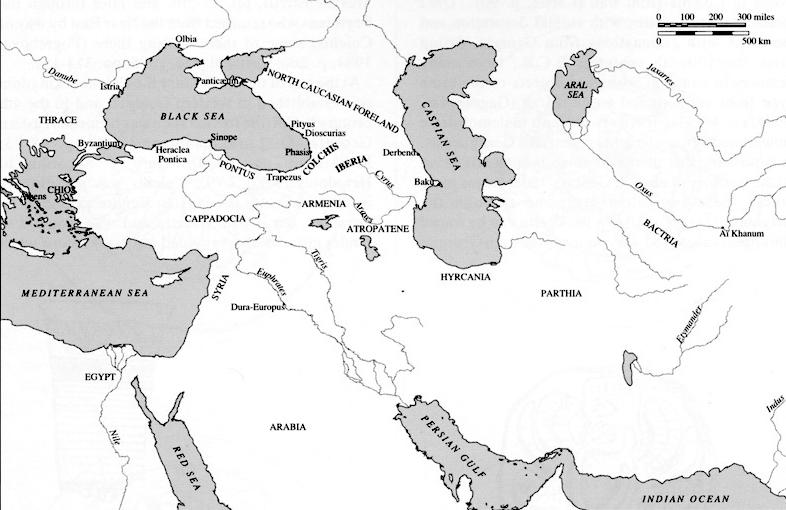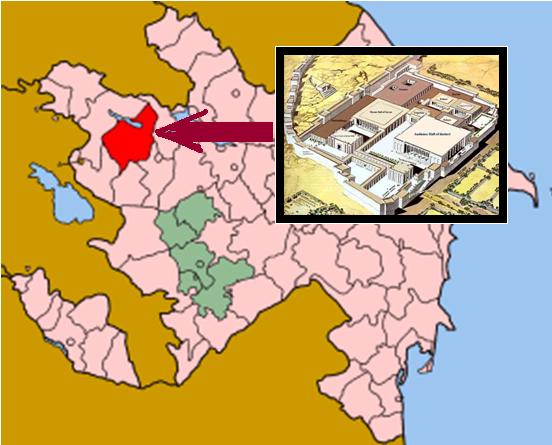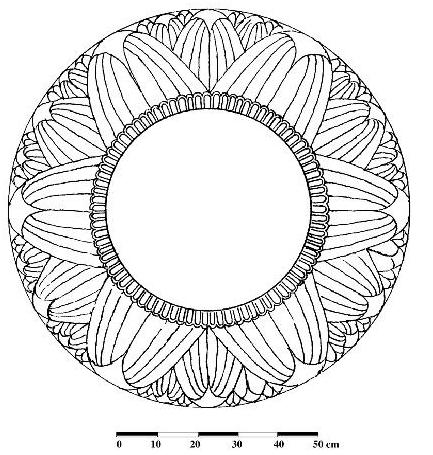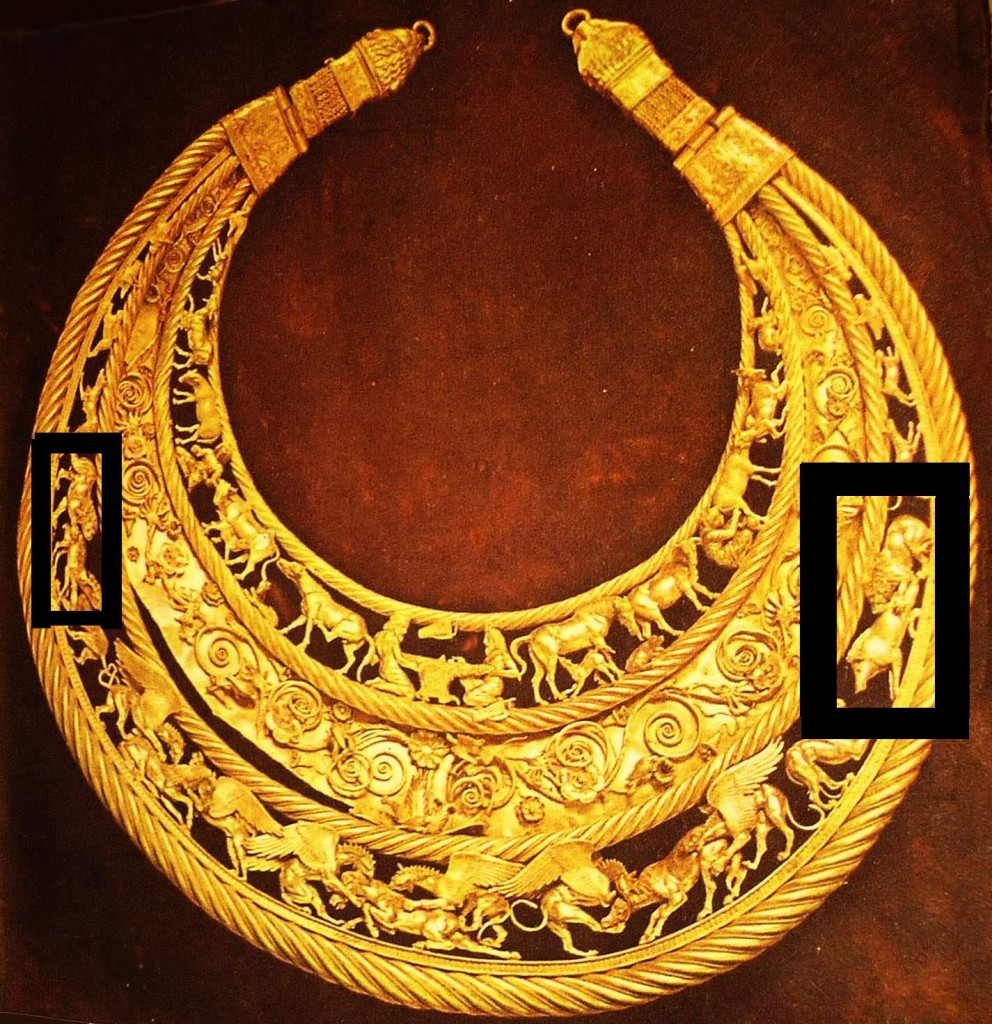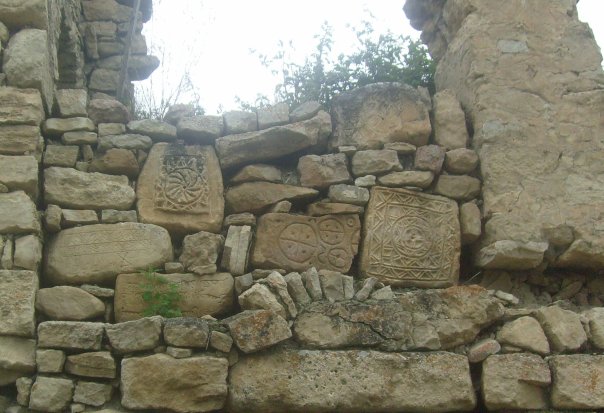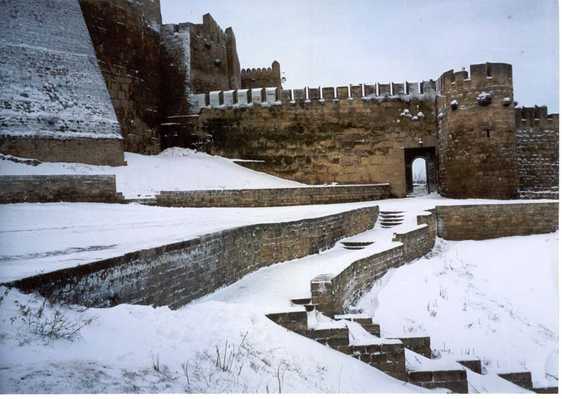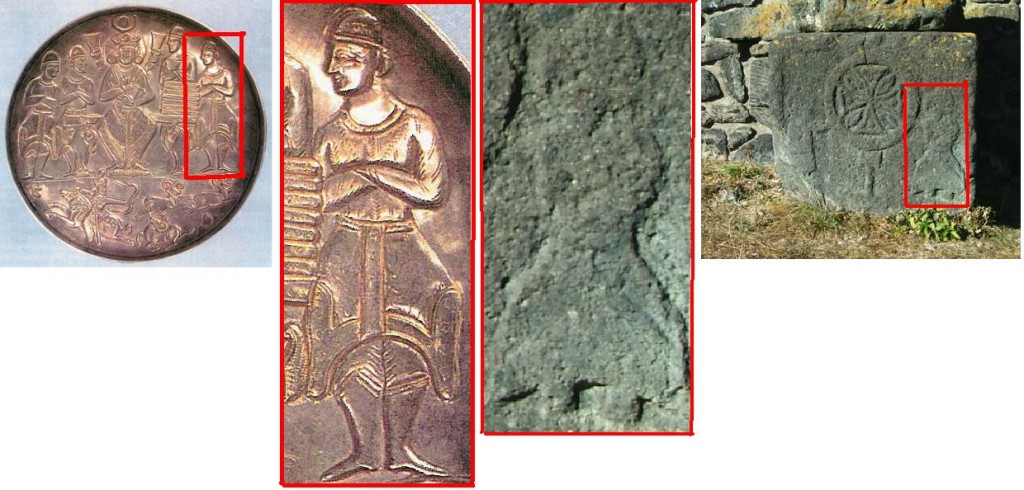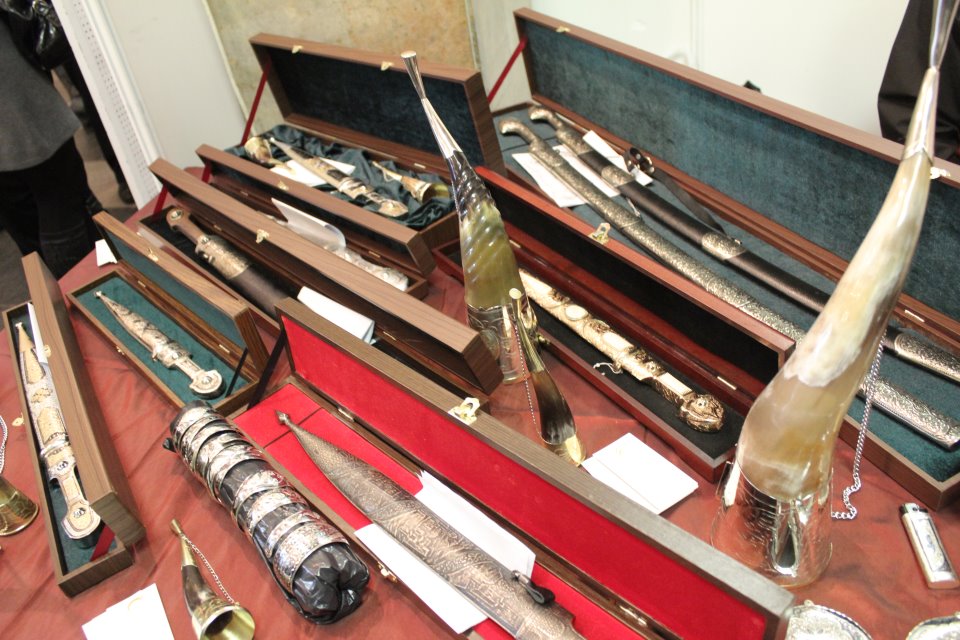The article below was written Fatema Soudavar Farmanfarmaian and originally appeared in the 2009 edition of the peer-reviewed Journal of Persianate Studies – below is that same article in pdf:
The above article is exemplary, well-researched and laden with excellent references.
The article has been embedded with pictures and captions from the Encyclopedia Iranica, Kaveh Farrokh’’s lectures at the University of British Columbia’s Continuing Studies Division and Stanford University’s WAIS 2006 Critical World Problems Conference Presentations on July 30-31, 2006.
Kavehfarrokh.com is especially appreciative of the permission granted by Leiden publishers, notably Ingrid Heijckers-Velt (acquisitions Editor | Middle East, Islam & African Studies) and Mieke de Vries Robbé (Legal Counsel at Koninklijke Brill). A special thnaks is also extended to Dr. Parvaneh Pourshariati (Associate Professor of History and Associate Professor of Near Eastern Languages at Ohio State & Cult at Ohio State University) and of course Fatemeh Soudavar-Farmanfarmian.
Given the length and breadth of topics of this article, Kavehfarrokh.com will be presenting this in two separate blog sections. Below is the first section (Abstract, along with relevant footnotes and references).
========================================================================
Abstract
When Georgia was incorporated into the Russian Empire, the rich background of interaction with Persian culture, the result of centuries of contact, was lost to the scholar whose interest in Georgian history came to depend on Russian historiography with its focus on the period under Russian rule and its misreading of anything prior to that. Western scholarship, often oblivious of the far reach of Persian culture, devoted too little attention to the subject or gave it short shrift. Owing largely to the recent work of Georgian scholars, a century of neglect is now being reversed, but an overall picture of the breadth and depth of Georgian-Iranian interaction is still lacking. This paper proposes to off er a general overview from the third millennium BCE to the Russian conquest of Georgia, when Persian influence began its decline.
======
According to family lore, the good looks of Hāj Kāzem Malek-al-Tojjār, this writer’s great-grandfather, were attributable to his mother, a Georgian princess converted to Islam upon her marriage to Āqā Mehdi of Tabriz. Th e latter, who was a battle companion and treasurer of the Crown Prince ʿAbbās Mirzā, had taken custody of the princess when she was a little child and did not marry her until much later, probably in 1837, the same year he received the title of Malek-al-Tojjār by a decree of Mohammad Shah
Over two millennia later, the Qajar Fath-ʿAli Shah’s favorite wife was the infl uential Georgian Tāvus Khānom (later Tāj-al-Dowla), for whose marriage to the shah the famous Peacock Th rone was made by jewellers in Isfahan (Bāmdād, I, p. 368; Pitiurishvili, p. 82). Georgian girls were also coveted by other segments of Iranian society, in large enough numbers to make a British historian of the early Qajars opine: “Th eir [= Georgians’] children, for ages, brought in large numbers into Persia and Turkey, have, by their intermarriage with the people of these lands, been the means of changing tribes, at fi rst remarkable for their ugliness, into handsome and pleasing-looking people” (Watson, p. 82). Apart from good looks, Georgian blood seems to have imparted to the off spring of such unions a phenomenal energy and an unshakeable morale, reminiscent of Gibbon’s description of “those who have breathed the keenness of the Scythian air.”
But there was more than good looks and vital energy to the history of relations between Iran and Georgia. Th e very geography of Georgia dictated a game of musical chairs between several worlds, which explains the recurrent pattern of alliances and counter-alliances, alternating with periods of fragmented autonomy, blighted by internal rivalries. By simply switching the names of the actors, one obtains similar situations repeated over time, with Iran a major player throughout. Even though Georgian princes of the eighteenth and nineteenth centuries cannot have been aware of the wealth of reciprocal contacts in antiquity, the residual eff ects were integrated into so many aspects of their lives that they cannot be ignored in an overview such as this, any more than they can within the context of Iran proper.
The connection between the two nations goes back to prehistoric times. Archaeology has established similarities between Georgia and the Iranian Plateau already in the Early Bronze Age, the fi rst manifestation of which is the ‘Kura-Araxes’ culture that embraced the area south of the Caucasus, northwestern Iran, and eastern Anatolia (Curtis and Kruszyinski, pp. 2f.). Th ough generally believed to have been a localized culture with links to the civilizations of the Near East, one should not discount the general trend observable in much of Eurasia in the Bronze Age, when a quantum leap was made in technology, arts and crafts. Th e ongoing revision of prehistoric cultures in the light of the discovery of the ‘Jiroft culture’ [see “Jiroft” under this link here] and its role in the transmission of goods and technologies should warrant another look at the Early Bronze Age.
Location of ancient Georgia (Colchis and Iberia). After Braund, p. xviii, map 1 (Source: Encyclopedia Iranica)
For now, the earliest evidence of known Iranian-Plateau elements on Georgian territory shows up in the metal and clay artefacts of the second millennium BCE, including a bronze rhyton believed to have been brought from the Plateau, and in objects with similar features made in local workshops (Tsetskhladze, p. 470). Other objects of the same period, such as the wellknown Trialeti goblet of 1500 BCE, continue to display symbols and rites associated with the Near East, including the Tree of Life (Lang, 1983, p. 533). As one moves forward to the eighth and seventh centuries BCE, Iranian infl uence, as represented by Luristan bronzes, picks up noticeably and gains the upper hand, especially on a number of bronze belts and belt clasps that continued to be used by the northern mountain tribes of Georgia and their steppe neighbors into the Christian era (Curtis and Kruszyinski, pp. 50-58, 71-83; Braund, p. 210). Painted pottery, weapons, and personal and equine ornaments were also often derived from Iranian models, possibly through the mediation of Urartu or of migrating Scythian tribes (Tsetskhladze, p. 472), both of whom were transmitters in both directions, as established by Stronach for monumental architecture (Lang, 1983, p. 506) and by the study of Scythian burial mounds.
The scant information on the Median period is legendary or late. In Herodotus’ account, which smacks of myth, Medea is considered to be a Mede, as her name suggests, though his allegation is based on the fact that the Persians are said to have regarded her removal from Colchis as “a wrong against themselves,” the second one, no less, that gave rise to war against the mainland Greeks (Braund, p. 9). Information from Strabo postdates the period by several centuries but is highly relevant in that it emphasizes the similarity of customs and lifestyles among the Medes and the Armenians, including, as quoted by Lang,
“their zeal for archery and horsemanship, and the court they pay to their kings,” and their dress which included trousers and “the tunics with sleeves reaching to the hands” [Footnote 3] (Lang, 1983, p. 525).
And the people of the plain of Iberia are said to have followed “both the Armenian and Median fashion.” The same is confirmed in later periods, as evident from sculpture and numismatics. Strabo, however, makes a clear distinction between the Iberians and the warlike people who inhabited the mountainous territory to the north and who had more in common with their Scythian and Sarmatian “neighbours and kinsmen” (ibid). The same differentiation is reported by Greek historians for the Achaemenid period. Herodotus mentions the eighteenth and nineteenth satrapies of the Persian empire, which are believed to have involved southern proto-Georgian tribes, as distinct from Colchians, while Xenophon refers to aggressive northern neighbors who successfully resisted domination (Hitchins, p. 464).
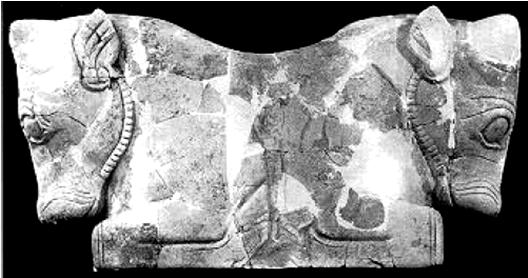
Ancient Georgian Column Capital discovered in Tsikha Gora (Courtesy of Gagoshidze and Kipiani). Note the striking resemblance to the column capital from Persepolis below (Picture and caption from Kaveh Farrokh’’s lectures at the University of British Columbia’s Continuing Studies Division and were also presented at Stanford University’s WAIS 2006 Critical World Problems Conference Presentations on July 30-31, 2006).
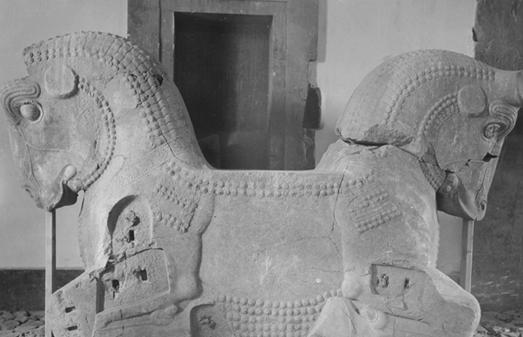
The double-bull motif column capital typical of Achaemenid-era architecture in sites such as Persepolis and Susa. Note the vivid parallels in style, construction and motifs to its Georgian counterpart. Architecture is only one of the many facets in which the ancient Caucasus and Persia have enjoyed mutual influences (Picture and caption from Kaveh Farrokh’’s lectures at the University of British Columbia’s Continuing Studies Division and were also presented at Stanford University’s WAIS 2006 Critical World Problems Conference Presentations on July 30-31, 2006).
Due to its riches and its strategic position on the eastern coast of the Black Sea, Colchis or western Georgia turns up in historical sources, including Urartian and Assyrian ones, earlier than eastern Georgia, wrongly named Iberia by the fi rst Greeks who set foot on its shores. Greek traders had been attracted to the eastern coast of the Black Sea which, to them, was “the farthest voyage” and as such well suited to myth (Braund, p. 3). Greek colonists, however, did not settle there as early as supposed; nurtured by myth, the fi rst ones arrived in the sixth century BCE, shortly before Cyrus the Great’s conquest of Lydia (idem, pp. 16, 73-118). As the land of Prometheus, Jason and the Argonauts, the Golden Fleece, the Dioscuri and Medea, Colchis would hold a special place in Greek and Roman perception, whether there was an active presence or not [Footnote 4].
Evidence, however, does not show any signifi cant exploitation of gold in the land of the Golden Fleece before the fi fth century, coinciding with the Achaemenid expansion into Georgia (idem, pp. 24, 124-26). Th e Greeks may have traded there earlier, as attested by pottery remains, but the fi rst period of prolonged prosperity and stability is associated there with Achaemenid hegemony in the fi fth and fourth centuries (idem, p. 122).
Well positioned to act as a buff er state on the periphery of the Persian Empire against the unruly northern tribes whom Darius I, as known from his disastrous Scythian campaign, was unable to subdue, Colchis became the recipient of luxurious gifts which, in turn, impacted local workmanship in bronze, in precious metals and clay (Tsetskhladze, p. 474). In addition to the quadrennial supply of young boys and girls, the Colchian élites regularly provided infantry contingents to the Persian army, including to Xerxes’ Grecian campaign, as did all the satrapies of the Caucasus (Braund, p. 123).
The fact that Colchis “acknowledged the Great King’s authority” but was not “officially a satrapy administered by Persian governors” (L. Allen, p. 95) suggests that its role in the empire was a loose and fl uid one. That does not preclude cultural infl uence, as attested by telltale signs including a growing corpus of archaeological objects in the Achaemenid style, the use of the Aramaic script for inscriptions and of the parasang (called ‘pauses’) for measuring distance (Braund, pp. 126f.), in addition to what Strabo mentions and more.
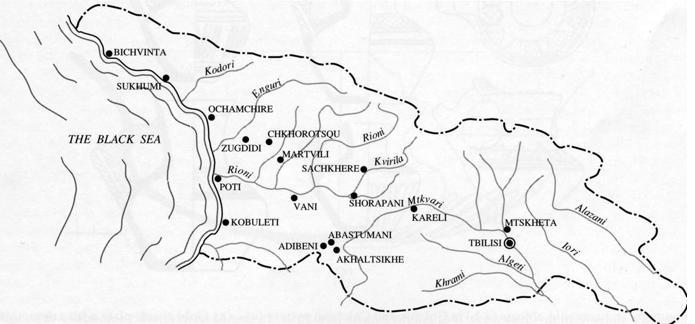 Map of Georgia with principal archaeological sites (Source: Encyclopedia Iranica).
Map of Georgia with principal archaeological sites (Source: Encyclopedia Iranica).
The rich trove of grave goods from Vani in the hinterland of former Colchis that was recently displayed in Washington and New York (2007) and at the Fitzwilliam Museum in Cambridge (2008) includes, in addition to Greek vases and the granulated goldwork of Colchis, magnifi cent examples of Achaemenid provenance or inspiration. That this was not fortuitous, but a calculated and systematic adoption, is attested by the fact that the metrological standards of the Persian Empire are proven to have been applied by local workshops (Kacharava and Kvirkvelia, p. 94 fn. 8). Th rough a large number of typically Achaemenid silver and gold phialae (used for drinking wine undiluted in the Iranian manner); through the silver goat-topped handle of an elegant ladle; through a wide range of bracelets with animal-head terminals; through an imported and locally modifi ed pectoral in Iranian Egyptianizing style; through the gold bracteates once sewn onto cloth (including two large ones in the form of the stylized Iranian eagle of the royal standard); and through the gold or silver tiaras of local workmanship with Iranian combat motifs engraved on plaques, the Achaemenid style is overwhelmingly present in Colchis in the fi fth and fourth centuries BCE and even beyond, in Graeco-Persian version [Footnote 5].
Not on display were the round bridle ornaments “with schematic depictions of Ahurā Mazdā” from the site of Sairkhe (Tsetskhladze, p. 474; Braund, p. 126). More than a borrowed icon, they indicate an adoption of Iranian religious symbols coexisting with indigenous rites at a time when assimilation was common in the ranks of some of the most cosmopolitan deities ever known (Lang, 1983, p. 532). In Colchis, two female deities reigned supreme (Kacharava and Kvirkvelia, pp. 35, 97-110). One of them, Leucothea, is likelyto have incorporated aspects of Anāhitā (or Nana), associated in Asia Minor with the Greek Artemis and the Anatolian Cybele (Braund, p. 190). Onlya shift in the focus of studies from a Western-oriented viewpoint to a more comprehensive one, such as is occurring in archaeology, will be able to tell.
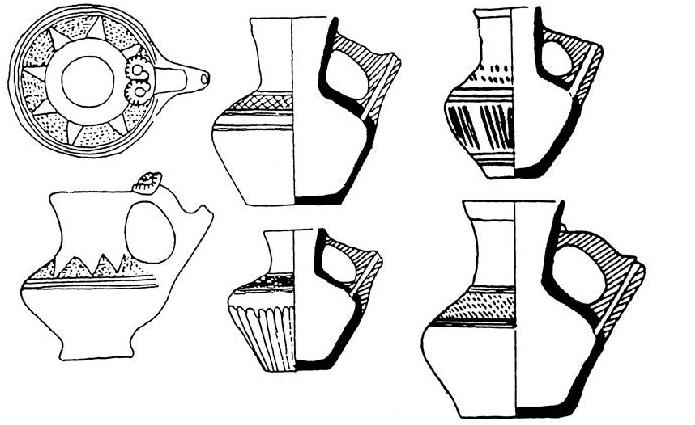 Ancient Georgian jugs with tubular handles; the pottery works of the Iran and the Caucasus have had strong links since antiquity (Source: Encyclopedia Iranica)
Ancient Georgian jugs with tubular handles; the pottery works of the Iran and the Caucasus have had strong links since antiquity (Source: Encyclopedia Iranica)
This is not to deny Greek influence, especially in the Hellenistic period from the third century, but nor does the latter invalidate the importance of the Achaemenid impact, especially in the Colchian hinterland, as the sites of Vani and nearby Sairkhe have shown (Kacharava and Kvirkvelia, p. 56). At the latter site, coexistence with the animal-style art of the Scythian steppes (Braund, pp. 130f.) once again places Georgia at a crossroads where cultures met and blended.
More unexpected, even for the hinterlands, is the presence of elements of Achaemenid architecture in Vani and Sairkhe, in the form of Persepolitan bull-protome capitals and bell-shaped lotus-leaf column bases, indicating “the presence of Achaemenid architects who decorated buildings for the local elite in the style of the Persian court” (Tsetskhladze, p. 474)—an obvious case of direct albeit rather crude imitation in a land blessed with timber and an established tradition of log architecture. Also interesting is a narrow kohl container made of thick glass, which is rightly said to be from northwestern Iran where glass containers for cosmetics and scents go back to early Achaemenid times (illustrated in Kacharava and Krikvelia, p. 61) [Footnote 6]. The example from Vani, which is shown together with several contemporary glass jugs from Rhodes, is one of many glass vessels from Iran, including glass bowls from the two Colchian sites and many more kohl and cosmetics containers from archaeological contexts in eastern Georgia (Tsetskhladze, pp. 473f.).
Graeco-Roman authors, on whose writings much of scholarship has been based, ignored or neglected the extent of Persian infl uence in Colchis and Iberia, if only because the Romans, who penetrated south of the Caucasus as of Pompey’s wars against Mithridates of Pontus, were notoriously uninterested in local culture or its sources (Braund, p. 216 ). That limited perspective is increasingly challenged by archaeological fi nds. Nonetheless, it is important to note that the Achaemenid period is rather atypical of Colchis which, being the other, Graeco-Roman face of Georgia, was to be drawn ever more, by virtue of geography, into the Roman, Pontine, Byzantine and much later, Ottoman spheres, and therefore does not fi gure as prominently in subsequent Iranian-Georgian relations except in the mid-Sasanian era.[Footnote 7].
While Colchis looked mostly west in the direction of the Black Sea, Iberia tended to look towards the Iranian Plateau with some nods to the west, whenever required, to assert independence. In the Achaemenid period, eastern Georgia was fi rmly within the Iranian sphere. The treasures from the Akhalgori and other large hoards confi rm that Iberia must have been a full satrapy where conscious and skilfully executed imitations of Achaemenid-style rhytons, phialae and vases with animal-shaped handles were manufactured in large numbers by craftsmen in precious metals or in less costly painted clay imitations (Tsetskhladze, pp. 474f.).
An Iranian legacy in the Caucasus. To the south of the Republic of Georgia is Shamkhir located in the Republic of Azarbaijan (ROA) (known as Arran until 1918). Shamkhir is located some 350 kilometres west of Baku near the Armenian border to its west. The CAIS website hosted by Shapur Suren-Pahlav reported on August 28, 2007 that Archaeologists from the ROA, Georgia and Germany unearthed ruins of a monument dated to the Achaemenid dynasty in the town of Shamkhir. The head of the archaeology team stated that: “During the excavation, we found traces of a 2500 year old historical structure…which has one 1000 square meter chamber surrounded by several smaller rooms…The ruins indicate that this area was once an important Achaemenid centre in the northern provinces in the Caucasus” (Picture and caption from Kaveh Farrokh’’s lectures at the University of British Columbia’s Continuing Studies Division and were also presented at Stanford University’s WAIS 2006 Critical World Problems Conference Presentations on July 30-31, 2006).
The Persian influence in the architectural remains of Iberia is by now well established. Especially frequent is the Persepolitan theme of bull-protome capitals and bell-shaped bases from Tsikhiagora and Dedepolis Mindori (one of the earliest excavated) which were used in palatial architecture and in fire-temples dating from the late Achaemenid to the Parthian periods (idem, pp. 475f.). The most important discovery of recent years is one of a series of Apadana-style columned halls that are known to have been built throughout the area stretching from eastern Anatolia to the Caucasus, “to mirror Persian palace architecture” (L. Allen, p. 95).
The one at Gumbati, in eastern Georgia, dates from the fifth century BCE, and probably housed the local satrap’s palace, with “a deliberate parallel . . . that strikingly recalled an Achaemenid āpādānā complete with sculpted column bases “imitating those found at the Iranian palace centres,” and was then apparently “new to the building traditions of the area” (ibid.) [Footnote 8].
It is not unlikely that Colchis borrowed its stone capitals from Iberia rather than by a more direct means. The life-cycle of these styles continued beyond the end of the Persian Empire, as attested by a post-Achaemenid six-columned āpādānā great hall unearthed at the important site of Armazi, high above Tbilisi (Lang, 1987, pp. 416f.). Nor does it stand alone; recent discoveries that clearly demonstrate Persian architectural infl uence include a fi re temple within a fortifi ed enclosure, and a probable Anāhitā temple, dating to the turn of the Christian era, with archaic features traceable to Susa, indicating a deeply-rooted penetration of art forms from Iran.
That fire temples attracted ordinary people as much as pagan images was witnessed by Saint Nino, the patron saint of Georgia, as related later in the story of her life (Lang, 1983, p. 534). Also signifi cant is a Parthian ayvān in the rock-hewn site of Uplistsikhe which, dating from the late fi rst century CE, must surely be, together with the palaces of Hatra and Ashur in northern Iraq and the remains of Mansur Tepe near Nisa (now in Turkmenistan), one of the earliest examples of a Parthian architectural theme that was to become the primary and most elegant feature of Iranian architecture in the Islamic period9 (Akhvlediani and Kimshiashvili, pp. 9f.). Th e widespread use of the ayvān and the evidence from Armazi, which includes a Greco-Aramaic inscription, is in keeping with what is known from recorded evidence about Georgia in the Seleucid and Parthian periods, based on the two key names that form the foundation stones of a sovereign Iberia.
The first of these two names, as recorded in chronicles and inscriptions, is that of Armazi—the first capital of Iberia (or Armaz-tsikhe, i.e. citadel of Armazi or Mtskheta-Armazi), which, like the Aramazd of the Armenians “took its name from the local embodiment of the Zoroastrian deity Ahurā Mazdā” (Lang, 1962, p. 23).
Architectural remains from Colchis (Source: Encyclopedia Iranica)
Armazi thus headed the Georgian pantheon, in a syncretistic cult that maintained some local pagan gods and probable vestiges of the past infl ux from the Near East, as well as incipient Greek infl uence that would grow with Roman and Byzantine intervention (Lang, 1983, pp. 532-36). Nor was Iranian religious infl uence limited to orthodox Zoroastrianism. Mithraism and possibly Manichaeism also made their way into Georgia. Silver bowls depicting a horse standing ready for sacrifi ce before a Mithraic fire-altar, dating mostly from the second century CE, confi rm that Mithraic rites were well known as they were in neighboring Armenia where the brother of the last Orontid King was Mithra(s), the chief priest of the Temple of the Sun and Moon at Armavir (ibid) [Footnote 10]
A native cult of the Sun did exist in both Colchis and Iberia, and their rulers had long prided themselves on being sons of the Sun. But Iranian Mithraism, introduced by the Achaemenids, if not by the Medes, must have reinforced pre-existing beliefs, long before the Roman cult of Mithras was born in the borderlands between Rome and Iran.
Rayfield recognizes the signs of a Mithraic cult in the imagery of the dream of the first king of Georgia (sun, deer and dew), without making clear which Mithraism is meant (Rayfield, pp. 60f.) Nonetheless, some Georgian scholars (and even Braund) link the Mithraic imagery to the (Roman) cult of Mithras, despite the presence of Middle Iranian inscriptions on some bowls (Tsetskhladze, p. 477) [Footnote 11].
At a time when murky attributions were made all too lightly and even the name of Armazi was believed to be derived from the Hittite moongod Arma (Gvelesiani, 2008, p. 175), the connection to Iranian Mithraism was evidently misunderstood [Footnote 12]. Georgian scholars are treading on hitherto unexplored ground to explain solar symbols as they should have been doing, but were not. Gvelesiani has unveiled the long overlooked signfi cance of the Sun and its association with sacral kingship, in the name of the first Georgian king, Pharnavaz (P’arnavaz), the second of the two crucial names that went into the making of Georgia.
Gvelesiani, who had earlier broached the subject (Gvelesiani, 2004), rightly links Armazi with the concept of xvar(ə)nah or farr, the Divine Light of Glory, by the bestowal of which Ahura Mazda legitimates the rule of monarchs who can also be divested when deemed to be unfit. The concepts of xvarnah and sacral kingship had an enduring career in Iran with many off shoots beyond. It was only natural that the impact should have been strongest in those lands that were directly affected by Persian culture and its concept of divinely sanctioned kingship.
Avestan concepts such as the xvarnah, and the supremacy of Ahura Mazda, arguably two of the three primordial aspects of Zoroastrianism (together with dualism), were introduced into Georgia by the Achaemenids (or even the Medes), as attested by the existence of fi re temples, and were rooted enough to justify their association with King Pharnavaz through the god Armazi. Basing her argument on dreams attributed to both Cyrus the Great and Pharnavaz, which in both cases feature a divine ray of light emanating from the Sun, Gvelesiani interprets the otherwise inexplicable words attributed to Pharnavaz—“For in Persian they called Pharnavaz Armaz”—as signifying the xvarnah, and thus avoids elusive attempts at etymological justifi cation for the identifi cation of Pharnavaz with Armaz (Gvelesiani, 2008, pp. 175-81).
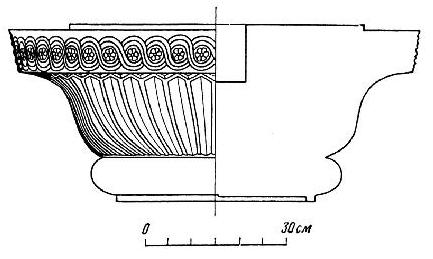 Architectural remains from ancient Iberia, Dedoplis Mendori (Source: Encyclopedia Iranica)
Architectural remains from ancient Iberia, Dedoplis Mendori (Source: Encyclopedia Iranica)
Pharnavaz is reported to have reigned at about the time of Alexander, in the third century BCE. Much myth has crept into his story, as known from the extant version of his life in the fi rst Georgian Chronicle, Kartlis tskhovreba‘Life of Georgia,’ the core of which dates to the fi fth or sixth century CE, by which time the country was largely Christianized. Brosset, basing his assertion on Georgian and Armenian sources, affirms that Pharnavaz was the son of a Persian woman (from Isfahan) and of the brother of Samara, the governor of Mtskheta at the time of Alexander. Armenian sources make his mother Persian and a sister of the same Samara “which would destroy the Georgian origin of the character,” as Brosset concludes with a hint of regret. Orphaned as a child, Pharnavaz imposed himself as king of Georgia with the help of Antiochus, i.e. Soter (Brosset, pp. xxvii f.).
Nonetheless, both his name and the incestuous union of the parents imply that he was a follower of Zoroastrianism. The name and the culture of Pharnavaz, as well as the account of the liberation of Georgia from the Macedonians speak in favor of a Parthian Arsacid origin, even though his alleged descent from Kartlos who gave to the country its Georgian name, Sakartvelo, suggests intermarriage with native nobility, perhaps over an extended period (Lang, 1983, p. 514). Brosset, who mentions an Arsacid link at a much later date, does not refute the Georgian perception of an uninterrupted monarchy through three dynasties in over two thousand years, thanks to intermarriage between various branches of the Georgian royal line, but always going back to the first king, Pharnavaz (Brosset, p. xlvi).
One might argue that the glue that ensured continuity may have been the lingering idea of the xvarnah more than lineage and blood. A divine legitimation was essential after Pharnavaz allegedly liberated Georgia from the Macedonian yoke and set out to rebuild that which was “destroyed by the enemy” and establish dynastic rule by adopting administrative structures “like the Persian Empire” (Gvelesiani, 2008, pp. 175f.).
Since Alexander never reached Georgia, the legends associating Pharnavaz with his name are spurious, though stubborn and persistent. Alexander’s name commonly fi gures in events that postdate his short life and Georgian legends have not remained immune to the fascination of association with his myth [Footnote 13].
Nor does Seleucid rule seem to have extended into Georgia (Lang, 1983, p. 514). Th e legend of Pharnavaz would make no sense if it did, unless the dates are wrong. The existence of Greek coins and Greek inscriptions or epitaphs side by side with Aramaic ones (in so-called Armazi script) neither confirm nor negate Seleucid rule. Bilingual inscriptions prove very little, since they were just as common in early Parthian Iran, where the Parthian-speaking élite was well acquainted with Greek [Footnote 14].
Pharnavaz was obviously more at home with the Persian legacy both in religion and in administration than with anything Greek. In reorganizing the army, he appointed a commander-in-chief from the royal line as spaspet, not as strategos (ibid). That implies the use of Parthian rather than Greek as the common tongue, together with Georgian which was unwritten as yet.
At any rate, the system adopted paid off. Under Pharnavaz and his successors Iberia came into its own as a distinct entity and thrived, so well that it is said to have been a land of “eye-catching” prosperity in the first century CE when it began to attract the attention of Rome (Braund, p. 205). The “spasmodic” Roman incursions which resulted in “varying degrees of success or disastrous failure” (Lang, 1983, p. 516) did little to erase the strongly Iranized culture of eastern Georgia [Footnote 15].
That the legacy of Pharnavaz continued is evident from the preponderance of Iranian theophoric names indicating some form of commitment to the Zoroastrian faith. That those who bore such names may have nevertheless not gone unopposed, is suggested by the fact that a Pharnajam was killed for having replaced idolatry with the religion of the Magians (Brosset, p. xxix). But the continuing prevalence of Iranian theophoric names, such as Pharasman (Pharasmanesh), Mihrdat/d (Mithridates), Adarnase (Adur Narseh), Baaman (Bahman), Trdat (Tirdād), Mirian (Mehrān), and others tend to indicate that any such opposition was probably sporadic or isolated(Chkeidze, p. 487) [Footnote 16].
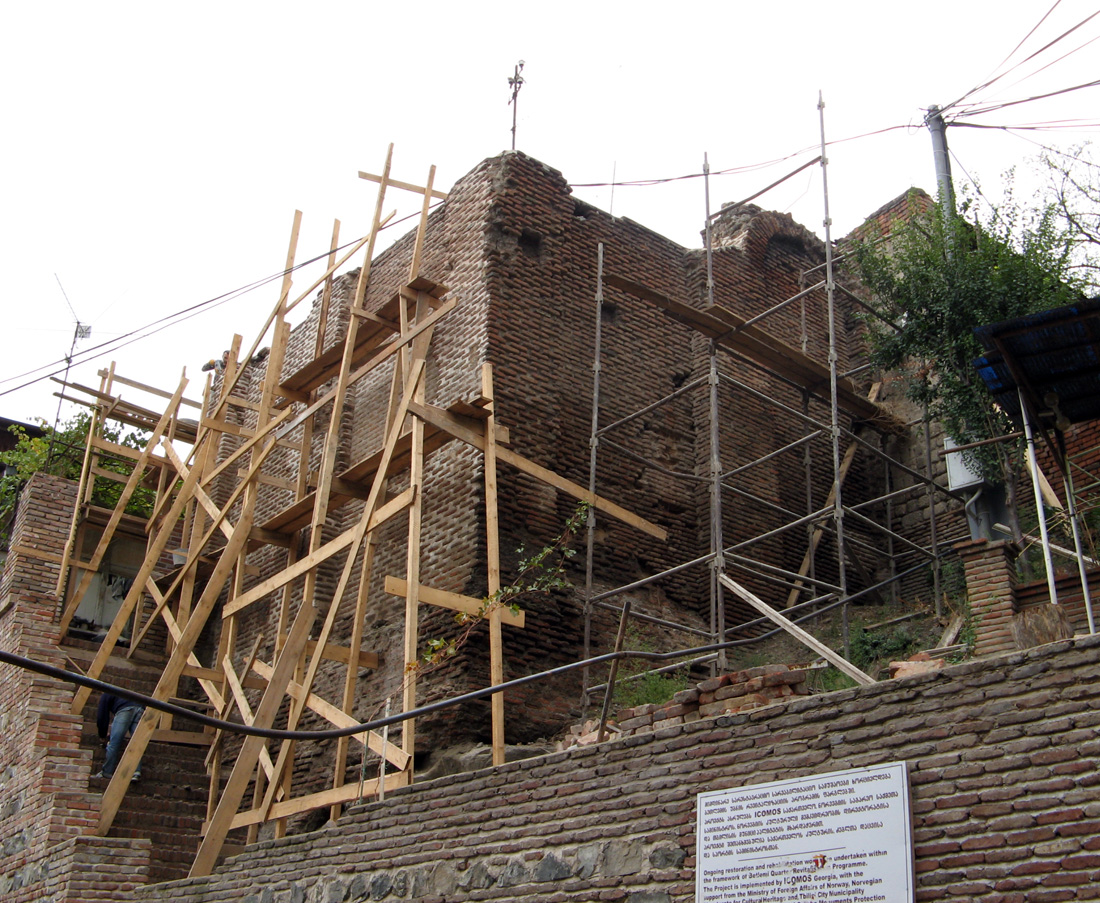
Remains of an “Atash-kade” (Zoroastrian fire-temple) undergoing repairs in Georgia. The cultural ties between Iran and Georgia stretch back for thousands of years (Picture courtesy of Dr. David Khoupenia with caption from Kaveh Farrokh’’s lectures at the University of British Columbia’s Continuing Studies Division and were also presented at Stanford University’s WAIS 2006 Critical World Problems Conference Presentations on July 30-31, 2006).
Equally popular in Georgia were Iranian epic names which, though said to have made their entrance later with the Shahnama, may in some cases have made an earlier appearance through other channels. Gvelesiani cites Triton (later Pridon; cf. Av. Th raetona, Pers. Faridun) as an example of an epic name transmitted by Scythian or Alano-Ossetian tribes to the north. The same may be true of the names of two well-known Georgian princes, Asparukh and Hamazasp (Gvelesiani, 2008, p. 181 fn.) [Footnote 17].
Purely historical names, such as Peroz, Khosro, Arshak (Ashk/Arsaces), Papak or Artashir (Ardashir), together with epic names such as Spandiat (Esfandiar/Spendadates) and Kekapos (Kaykavus), may have also gained in popularity through tales spread by the mgosani (gōsāns), the roving bards who sang the exploits of warriors, heroes and kings (Lang, 1983, p. 536; Gavkharia, 1995, p. 441). Even in later Christian Georgia, Iranian names stand out, though their origin may have been forgotten by then; for example, Vakhtang, which Gvelesiani, quoting the historian Juansher (who gives Varan-Khuasro-Tang), traces back to the Avestan god, Verethraghna (Gvelesiani, 2008, p. 175).
There is irony in the fact that the momentous change from ‘idolatry’ to Christianity should have occurred under the aegis of a prince with the distinctly Iranian name Mirian (Mehrān), though the sacred link was provided by the revered figure of Saint Nino and her miraculous healing powers which she attributed to her faith in Christ. The story goes that the miracles triggered the conversion of Mirian and his consort, so that “they and all the people were [. . .] converted from Zoroastrianiasm and paganism to Christianity” (Lang, 1962, p. 6). “
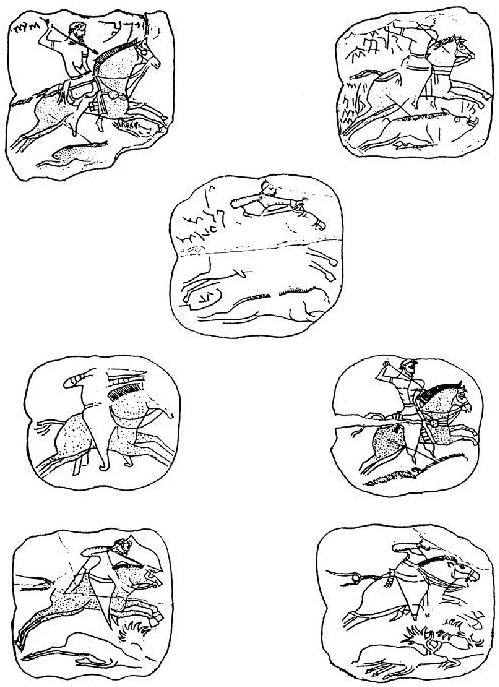 Bone engravings from ancient Iberia, Dedoplis Mendori, depicting the hunt with Aramaic inscriptions. The riding attire and hunting style of the horsemen is in the Iranian style (Medo-Persian and Scythian) (Source: Encyclopedia Iranica)
Bone engravings from ancient Iberia, Dedoplis Mendori, depicting the hunt with Aramaic inscriptions. The riding attire and hunting style of the horsemen is in the Iranian style (Medo-Persian and Scythian) (Source: Encyclopedia Iranica)
The people” included Jewish Georgians who had brought the loincloth of Jesus from Palestine and revealed its hiding-place to King Mirian when he was ripe to convert. The origin of the story is attributed to Rufinus, a church-chronicler in Jerusalem, as heard from a Georgian royal, Bakur.Braund gives the full version of the miracles wrought and their effects to show how the story integrates Greek and Persian symbolism, the latter including the royal hunt, the bull, and especially the stag which figures prominently in graves and grave goods in Georgia and is associated with the sun, not to mention the theme of darkness versus light in the episode that convinces Mirian (Braund, pp. 248-56) [Footnote 18].
Without the conversion of the royal couple, Christianity would not have been able to impose itself in Georgia institutionally. That makes the issue of Mirian’s identity both important and controversial. Was he really the son of a King Ardashir, usually equated with Ardashir Bābakān? Here’s what Brosset has to say about it: Georgians, who sometimes made incursions into the territories of Iran in periods of weak rule, apparently did so for the last time during the transition from the Arsacids to the Sasanian dynasty.
As soon as the founder of the latter, Ardashir I, had consolidated his rule, the kings of Georgia asked him to send them one of his sons, so the seven-year-old Mirian, born of a concubine, was dispatched to Georgia with the recommendation to persist in the culte du feu but to allow the Georgians the freedom to adore their own idols, including their god Armazi.19 Mirian went on to found the Khosroid dynasty of eastern Georgia, and then, in his fortieth year, claimed the throne of Persia, but was rejected because of his mother’s lowly birth (Brosset, xxxiii-xxxviii). For a long time it was believed, on the basis of his name, that Mirian may have been a Mehrānid, i.e. from the same illustrious Parthian clan as the rebel Bahrām Chubin (Lang, 1983, p. 520).
The tale of a rebel choosing a rival faith to spite his opponents would be plausible, were it not for the fact that Georgian versions give two different genealogies, one making Mirian the son of Rev the Righteous, and the other the son of a King Ardashir. Contrary to Brosset, most Georgian scholars give preference to Rev, while those who embrace the other version insist on the fact that Mirian was a bastard son of Ardashir. Th ey need not be concerned: a recent revision gives satisfaction to both camps with a new interesting twist [Footnote 20].
Manana Sanadze has convincingly demonstrated that both genealogies are actually correct—that Mirian was the son of Rev, that Rev was the son of Ardashir, that the Mirian of the one genealogy and the Vacha of the other are one and the same (Vacha being equated with the Persian bachcha ‘child’ and thus with seven-year-old Mirian), that Ardashir was in fact Hormozd-Ardashir, the son of Shāpur I and King of Armenia, and that his son Rev was sent to Georgia to become king (Sanadze, pp. 91f.). Th is still means that the canonized St. Mirian, who succeeded his father as King of Kartli, was not only a Sasanian prince, but a direct descendant of the high priests of Persis [Footnote 21]. So in Georgia, as in Armenia, the descendant of a Magian was responsible for establishing the new Christian faith.
[Click to Enlsrge] Golden necklace or pectoral of an ancient Iranian queen in what is now North Ossetia (in southern Russia to the north of the Georgian Republic). The areas shown with black rectangles depict lions attacking their prey – these are virtually identical to those seen in the Apadana stairway at Persepolis.
This revised genealogy does not affect the sequel, namely that Mirian applied to the Byzantine emperor, Constantine, and requested him to send a bishop and some priests, and at a later date, asked for a piece of the newly rediscovered true cross (Brosset, xxxiii-xxxviii). Th e culture of Mirian was clearly Iranian, as attested by the tenth-century work about the conversion of Georgia, which makes him declare, after mighty pagan idols in bronze, silver and gold are destroyed by a hailstorm, in mutilated Persian, ingeniously corrected by Georgian scholars: rāst mīgūī khojasta bānū wa rasul-e pesar-e īzad (Gvakharia, 2001, pp. 481f.).[Footnote 22].
Could khojasta bānu have been applied to the goddess Anāhitā and later diverted to St Nino in yet another transfer of older rites to which reluctant converts clung? At any rate, if Mirian’s words, which must have been originally uttered in Parthian or Middle Persian, were transmitted in the very new New Persian that evolved in Iran, that language must have been sufficiently widespread among Georgians in the period following the Arab occupation to justify its use for a text meant to be comprehensible to all Christian Georgians (Rayfi eld, p. 58). This is confirmed by Gvakharia who says that “already from the 10th century, the Georgians were acquainted with New Persian (Paris-Dari), even though it “intensified and strengthened in the 12th century” (Gvakharia, 1995, p. 242).
Zoroastrianism and Mithraism had a long tradition as did local paganism, and the conversion of Georgia did not happen without a struggle, as attested by the many martyrologies and hagiographies that constitute the bulk of the earliest known Georgian literature (Rayfield, pp. 40-62). The tug-of-war between Zoroastrianism and Christianity did not end there, because Sasanian rule did not end. If anything, it gained ground and spread to Lazica—the former Colchis where the Georgian Lazi had established hegemony slowly but surely and made the country prosperous through trade with Rome after a prolonged period of decline (Braund, p. 280). Lazica had retained enough Persianness to have a ‘significant’ pro-Iranian and pro-Zoroastrian faction at court, where there was “more than a whiff of Persia” (idem, pp. 272, 308). One would hardly know it by reading Procopius, the Byzantine historian who wrote his own version of events and attributed the worst of intentions to Khosrō I, not validated by historical facts (idem, pp. 297f.). The pro-Iranian faction was in turn opposed by a Christian one, with an avowed distaste for Zoroastrian customs. It was the abominable behavior of Byzantine commanders that eventually off set their revulsion and tipped the scales in favor of Sasanian rule. The first period of Persian presence in Lazica lasted from 470 CE, when the Sasanians resolved the conflict with the Kidarite Huns on their eastern border, until 522. The second one, under Khosrō I Anushiravan, was relatively brief.
By that time religion had become a political tool used effectively by both Byzantium and Sasanian Iran, with back-and-forth conversion of rulers to match and a great deal of suspicion on the part of each of the two powers regarding the intentions of the other and their shifty vassals. And in the background were Sarmatians and Huns waiting to raid or to be recruited by one of the two camps, as well as Abasgians and Suanians who welcomed Sasanian attempts to weaken Lazica by backing the autonomy of such small vassal states (Braund, pp. 268-314). Pro-Persian loyalties feeding upon disenchantment with Byzantium literally opened the way for Khosrō I, when the Lazi themselves guided his forces over the Surami ridge that made passage from eastern to western Georgia a very arduous task (idem, pp. 295f.). The problem of distance and therefore of supplies was a major one for the Sasanians, only partly alleviated by their building the first ever proper road over the ridge. Ironically, the Sasanians thus facilitated the later unification of Georgia under one rule (idem, p. 302).
The other factor that played against the Sasanians was active proselytizing by Byzantium among the discontent Lazi rulers who tended to switch from one camp to another as the situation required. To play off the one power against the other became a way of life for tributary rulers who were, as a result, regularly suspected of treason by one side or the other. So, once again, we witness the sort of bizarre situations that dot Georgian history: a Lazi ruler escaping the Sasanians only to be murdered by a Byzantine commander (Braund, p. 308); or the odd spectacle of a Christian king with the Persian name Gobazes (Qobāδ or Kavād), turning up at the court of Byzantium in full Persian costume, complete with bejewelled boots, and an escort of Persian style royal bodyguards (idem, p. 272). Sasanian rule was not likely to last on the shores of the Black Sea. It ended without leaving the Lazi any happier with Byzantine rule.
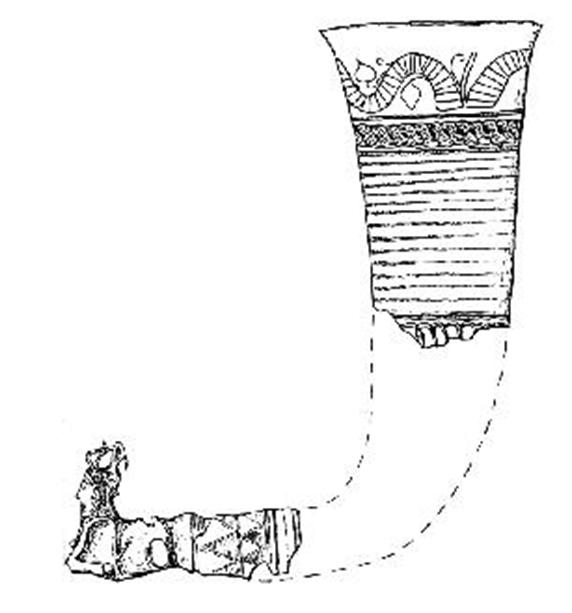 Achaemenid objects in Colchis: silver rhyton Mtisdziri, environs of Vani. Adapted from Gamkrelidze, fig. 21 (Source: Encyclopedia Iranica ).
Achaemenid objects in Colchis: silver rhyton Mtisdziri, environs of Vani. Adapted from Gamkrelidze, fig. 21 (Source: Encyclopedia Iranica ).
In Kartli, the situation was rather diff erent. Soon after the Sasanians seized power and set out to retrieve the former territories of the Achaemenids, Shāpur I claimed Wirzhan—the term used for Kartli in his inscription at Kaʿba-ye Zardosht. As of then, a Georgian royal was appointed to rule not as vassal, but as viceroy or pitiaxsh (bidakhsh)—corresponding to the later position of vāli.
The title became hereditary in the lower house of Kartli and gave another boost to Persian culture without ending religious competition between the new and the old (Hitchins, pp. 464f.). For a time Zoroastrianism and Christianity lived in peaceful symbiosis, though at times uncomfortably, as recorded in the first work of Georgian literature, The Passion of Queen Saint Shushanik, about the wife of a pitiaxsh, who converted to Christianity and was tormented to death by a husband bound steadfastly to Zoroastrian beliefs (Rayfield, pp. 42-44).
Shāpur’s high priest, Kartir, was to blame. He devoted his energy to the propagation of orthodoxy in Ērān ud Anērān, and the suppression of heresies, including Christianity and Manichaeism, both of which he abhorred. This resulted in devastating wars, cruel deportations and the antagonism of the very people whom it was intended to maintain within the folds of orthodoxy.
Such a policy was bound to backfire. The Sasanian emperors, left to their own devices, were more pragmatic, as they tried to redirect Georgian, Armenian and Albanian (Arrani) Christianity towards a unified Monophysite Church that would bring them closer to the Christian church of Iran (Hitchins, p. 465). It worked better for Armenia than for Georgia.
Meanwhile, Byzantium used its own ploys to bring together religion and expansion in one and the same diplomatic package, mainly in Lazica but with ripples that crossed into Kartli to become waves of unrest (Braund, pp. 280, 286f.). The ‘semi-legendary’ King Vakhtang I Gorgasa(r)—thus known because of his wolf-shaped helmet—reacted and led a revolt that championed the unification of the two parts of Georgia at the height of Sasanian hegemony in Lazica [Footnote 23]. His death in battle earned him a hagiography written by the eleventh-century Georgian historian Juansher (Jovānshir; idem, pp. 282f.). Yet, even though Gorgasa(r) had used the church to combat the hated ‘Persian Christianity’ and assert independence, he himself was married to a Persian princess. Indeed, the early part of his career had been devoted to guarding the northern passes for the Sasanian Empire and to Sasanian campaigns against Byzantium and Sind (possibly against the Hephthalites in 474-76). His and his successors’ failure to unite Georgia resulted not so much from the protracted struggles between two empire as from frequent rivalry between the ruling house of Georgia and the landed nobility (Lang, 1962, pp. 27f.).
Another revolt in 523 CE against the imposition of Zoroastrianism by Yazdegerd II (439-57), probably with backing from the prime minister Mehr-Narseh, was led by Gourgenes (Gurgen) who fled to Byzantium with a plea for assistance in that same year (Braund, pp. 282f.). The revolts he fomented from afar led Hormozd IV, generally considered a friend of the Christians of the empire, to depose the Georgian monarchy and appoint a marzbān instead of the pitiaxsh, thereby making Kartli a full province of the Sasanian Empire, with the Zoroastrian flame restored on locally-minted coins instead of the Christian cross (Lang, 1983, p. 512). This was done with the complicity of the scions of Georgian nobility who hoped to manage their aff airs without any interference (idem, p. 530).
It did not work out that way. Finally Emperor Maurice and Khosrō Parviz II agreed, in 591, to end their warfare and divide up Kartli. Tbilisi, the new capital founded by Gorgasa(r), retained Persian rule, while Mtskheta, the old capital associated with Christianization, fell to Byzantium. This corresponded to the reality of Georgian society which always had a strong pro-Persian element in opposition to a pro-Roman one. A brief attempt in the early seventh century to reunite all of Kartli with Iranian help was foiled by Emperor Heraclius shortly before the Arab invasion which did not spare Christian Georgia any more than it did Zoroastrian Iran (Hitchins, p. 465). As in Iran, it came to an end in about two centuries, but, contrary to Iran, it left little imprint except on language (Rayfield, p. 46).
The cyclical pattern is interesting to note. Much the same scenario would be re-enacted from the sixteenth to the eighteenth centuries, with slight variations of sequence and names, but including major leitmotivs such as the divided loyalties of the Georgians themselves, the participation of a Georgian monarch in Iranian campaigns in Anatolia and India, and punitive expeditions sent by Iranian rulers to Georgia in retaliation for the refusal to submit, followed by reconciliation until another power stepped in.
Wall bricks from an ancient Lezgian structure in Koosar, modern-day Republic of Azarbaijan (known as Arran or Albania untuil May 1918). (Courtesy of Enver Abdulayev, Leader of the Lezgian Youth Organization of the Russian Federation).
The Christianization of Georgia may account for the fact that the long period of Sasanian rule has far less to show than the Achaemenid period in terms of the artistic influence from Iran. The main finds consist of hoards of silver derhams minted in Iran, which, as in the Parthian period, coexist with a few Roman coins. In addition, there are some silver dishes or bowls sent as gifts to loyal nobles who invariably bore Sasanian names such as Papak or Bahram. There are oddities among the silver dishes. One bears the portrait of Bahrām II with his wife and son on a silver kylix of Greek form [Footnote 24]. Another is a Sasanian silver bowl with a Parthian inscription on the reverse, suggesting perhaps that Parthian speech persisted in Georgia in defiance of both the Sasanians and the Christian Church (Braund, pp. 237, 242f.).
It is very little, by comparison with the number of Sasanian silver dishes found in the Black Sea region and the Urals, access to both of which is likely to have been through Georgia. One can only surmise that plundering has taken a heavy toll or that future excavations have yet more to reveal, unless Sasanian art simply had a lesser appeal. However, the fact that Sasanian motifs found their way into Georgia’s Christian art, in syncretism with Byzantine iconography, suggests that a significant quantity of silver bowls must be lost to us.
Motifs such as lions and other beasts carved on friezes and stone capitals of Christian churches in Georgia and Armenia are clearly of distinct Iranian descent. Even Church architecture, with its cruciform domed plan, is somewhat reminiscent of the Sasanian chahār-tāq, though a direct transmission seems a little far-fetched (Lang, 1983, p. 532). In every other respect, the long period of Sasanian hegemony reinforced the legacy of Pharnavaz.
Christianity imposed a different world-view, but did little to change rooted institutions that were not in its way. The Georgian annals and the early lives of the saints “all point to a profound influence exerted by Arsacid and Sasanian Persia on the evolution of Georgian institutions in pre-Mohammedan times” (Lang, 1957, p. 37) [Footnote 25].
The Persian institutions established by Pharnavaz may have done no more than restore the earlier Achaemenid precedent. That included not only administration, but landholding patterns and feudal structure. Indeed, what the first Western observers of Georgia viewed as astonishingly similar to medieval European feudal structures was a combination of Sasanian and Byzantine institutions, with some allowance for local traditions, according to Lang (1962, p. 27). His enumeration of their common features demonstrates how the Georgian feudal structure could have been confused with medieval European feudalism (Lang, 1983, p. 528).
The institutional framework derived from Iran also included the equally medieval principal punishments meted out by law to Georgian wrongdoers, such as blood money (wergild ), the ordeal of single combat and that of boiling water or molten metal employed to establish innocence. The first Russian scholars of Georgia had presumed such customs to have been introduced from the Frankish kingdoms of the Crusaders in the Levant (Lang, 1957, pp. 34-43) [Footnote 26]. Lang recognized that they dated back to “when Georgia was under the sway of Mazdeist Persia” (ibid) and traces the ordeal of boiling water, as invoked in the judgement of Mithra, to the Achaemenid era, but attributes the ordeals of fi re and molten metal to the Sasanians.
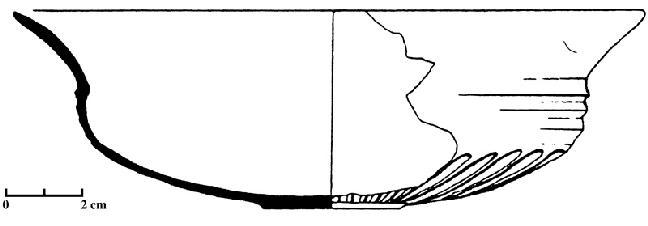 Achaemenid glass phiale in Colchis (Source: Encyclopedia Iranica).
Achaemenid glass phiale in Colchis (Source: Encyclopedia Iranica).
Such punishments continued under the aegis of the Christian Church, as witnessed by Chardin in seventeenth-century Georgia, where single combat and the associated ritual was considered to be a reliable test, no less than “going to the tribunal of God” (Chardin, I, p. 289; cf. Lang, 1957, p. 35). Some of them survived into the early eighteenth century, when they were incorporated by King Vakhtang VI into the mix of precedents that went into his reformed code of law and remained in force until Russian rule put an end to Georgian archaisms (idem, p. 37). No matter how harsh such punishments and worse may have seemed to foreign observers, Lang does not give the moral high ground to Europeans when comparing them with what went on in Georgia:
[. . .] the system compares favourably with the savage and senseless penalties inflicted at that time in countries reputed socially and politically more advanced [. . .]. Georgians [. . .] at least remained free of the shadows of the dungeon and the galleys, the rack, the wheel and the knout, which were such grim features of life in Europe during the seventeenth and eigtheenth centuries (Lang, 1957, p. 48).
Nor did Christianity erase other vestiges of Iranian religions and popular lore (Lang, 1983, pp. 535f.) The words for ‘sin’ and ‘hell,’ to name just two, are Georgian versions of their Iranian counterparts; interestingly, eshmak-i, from the name of the Zoroastrian demon of rage, Aeshma (Pers. xashm) denotes the ‘devil’ in Georgian (Chkeidze, p. 488). Inevitably biblical names came to the fore, but the most popular Iranian epic names survived (Rostom, Zal, Luarsab, Zurab, Ketevan, Taimuraz, etc.) and did so long after most of them had fallen into disuse in Iran except in an epic context, until the Safavids decided to bestow ancient Iranian names on Georgians of high rank in their administration, for the latter—rather than the Qizilbash amirs or the Shiite clergy—were deemed to represent the glories of ancient Persia which the dynasty wished to resurrect (Babaie et al., p. 37) [Footnote 27].
Influence on Georgian Literature
Georgian nationalism, promoted by a new dynasty, the Bagratids (Bagrationi), came back with a vengeance after the end of Arab rule in the ninth century. Yet these promoters of a Georgian Christian state had Iranian links too, other than their claim to descent from Pharnavaz. Th e name of the eponymous founder of the dynasty, Bagrat, is Iranian (Old Pers. Baga.dāta ‘God-given’), and his ancestry went back to Achaemenid Iran. Little is known about Bagrat himself, but his origin can be traced to the Armenian Bagrationi who were the coronants of the Armenian Arsacids. The latter were, in turn, an off shoot of the Orontid satraps of the Achaemenids in eastern Anatolia, and later became kings of Armenia with an uninterrupted geneaology going back to 555 CE.
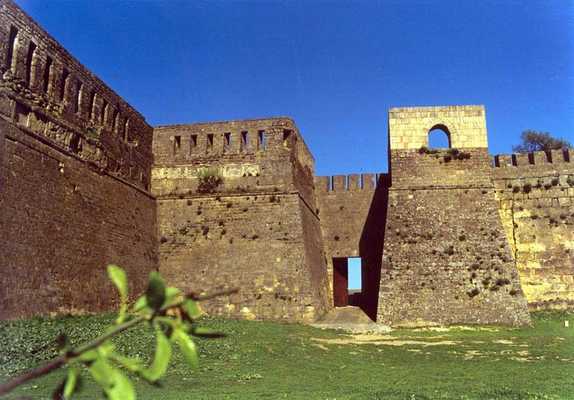 The Wall of Derbent (also known as Krevar to locals) in Daghestan as it appears in summer. This is an enduring testament to Sassanian military engineering in the Caucasus (Source: World Historia).
The Wall of Derbent (also known as Krevar to locals) in Daghestan as it appears in summer. This is an enduring testament to Sassanian military engineering in the Caucasus (Source: World Historia).
They too claimed descent from a solar deity, and judging by the monumental statues of another off shoot of the Orontids, the rulers of Commagene in Anatolia, this deity combined features of Mithra and his Greek counterpart Helios (Toumanoff , pp. 419-22) [Footnote 28]. When the Christian Church reattributed the origin of the Bagrationi to the biblical David, it eff aced the memory of their historical roots. Such reattributions were not specific to Georgia alone; invented genealogies and myths of legitimation are a means of imposing a new rule and usually supersede facts by spreading a new truth. The usual version of Bagratid accession to power in Georgia has it that, after Smbat VII of Armenia was killed in battle against the caliphal forces, his brother, Vesak, moved to Georgia some time after 775. Their descendant, Ashot I, founded the dynasty which, from being tributary to Byzantium, evolved into the Golden Age of the three illustrious successors of Ashot I, namely Bagrat III (r. 1008-14) who unified all of Georgia, David the Builder (1089-1125) and especially the fabled Queen Tamar (1184-1213), who ruled by ‘divine right’ over a pan-Caucasian empire that stretched to Ganja, Shirvan (Sharvan), Erzerum and Trebizond in one direction, and Tabriz and Qazvin in the other (Lang, 1957, p. 8; Gabashvili, p. 35).
Branches of the same dynasty continued to rule over diff erent provinces of eastern and western Georgia as semi-autonomous potentates until their deposition in 1801. With Iranian princes or princes tributary to Iran, regardless of the creed they embraced, had come not only names, institutions and customs, but also the related vocabulary. But after two centuries of Arab rule, followed by the Christian nationalism that succeeded hard on its heels, eventually leading to a brilliant Golden Age, one would expect the Iranian components in Georgian culture to have weakened, if not become almost extinct. Yet, in spite of the linguistic changes brought about by Church literature and the creation of a Georgian script in the fourth century CE (Rayfield, pp. 19-25), the number of surviving Iranian/Persian loanwords, though not on a par with Armenian, remains substantial to this very day.
Georgians had been borrowing from Iranian languages since the first millennium BCE, from Median, Old Persian, Parthian, Middle Persian, some of it through Armenian and, to a lesser extent, through Scythian or Ossetic, but the bulk of it by means of direct contact. In addition to titles, terms designating social rank or lineage, terms relating to military and commercial affairs and communications, Iranian loanwords cover almost every aspect of daily life, from animals (including mythical beasts) to plants and produce, to items of clothing and furnishings, and more.
New Persian added more over an extended period, from the end of Arab rule to the end of Safavid rule. As with names, however, some Georgian expressions have lost the memory of their origin, for example, ga-biabru-eba ‘humiliated, disgraced’(from Pers. bi-āberu), which gives expression to a concept shared with Iran and one that a European would be at pains to understand (Chkeidze, pp. 486-90).
This is why, during the apogee of Georgian national consciousness, deeply intertwined with its Christianity, Persian literature, then at the height of its poetic production, made major inroads into Georgian literature, providing the latter with its greatest classics. Gvakharia cites Marr, the founder of scholarly research into Persian-Georgian interrelations, as to why Persian literature had such a great appeal, namely because “Georgian feudal life, with its war prowess and chivalrous dealing, proved highly receptive to Iranian legends or romantic and heroic content” (Gvakharia, 1995, p. 241). Such was the attraction of fine Persian poetry that it left a long-lasting legacy for many centuries to come. It did not flourish on barren land, however; there was a precedent for the explosion of talent that took Persian literature as its model.
The tradition of epic writing in Georgia goes back to the Sasanian chronicles, the Khwadāynāmag, or related works, as initially suggested by Brosset (Brosset, p. xix) and now reconfirmed. The revealing passage in the Kartlis tskhovreba that indicates that “the author was familiar with a Persian literary work similar to the Xwadaynamag” (Gvakharia, 2001, p. 481) was detected by diligent Georgian scholars engaged in the study of the common origin of Georgian and Persian epic traditions: And then Iranians from the side of the sunrise [i.e. Khorasan], the kin of Nebrot, became strong. And there appeared among them one man, a hero named Afridon, who put Bevrasp, the master of snakes, in chains and tied him to a mountain inaccessible to human beings. All this is written in the History of the Persians (ibid) [Footnote 29].
The Wall of Derbent (also known as Krevar to locals) in Daghestan as it appears in winter. This is an enduring testament to Sassanian military engineering in the Caucasus (Source: World Historia).
The last title can only refer to the Khwadāynāmag. Since the literary tradition of pre-Christian Georgia was oral, it is difficult to establish the exact date of the penetration of Middle Persian literature into Georgia. It is likely that the mgosani or bards had a role in transmitting Iranian legends and chivalrous tales long before Sasanian rule, and blending it with local folktales that attracted commoners as well. During the period of Sasanian hegemony, the periodically updated Khwadāynāmags as well as Avestan texts and possibly other seminal works would have been made available to Georgians for their edification, though with serious competition from Christian literature as of the fifth century. Initially, most of the Georgian translations of church literature were made in other Christian centers, including Jerusalem (which has the oldest known text in Georgian), the Sinai monastery of St. Catherine’s and Mount Athos in Greece (Rayfi eld, pp. 20f.). The huge amount of work that had gone into ecclesiastical translations eventually led to the flowering of a Georgian literary tradition, with the composition of creative works in the form of hymns, homilies and hagiographies (idem, pp. 27-55).
Among the most famous lyrical poets was Ioane Zosime, who wrote in Palestine in the tenth century and compiled his hymns “for learned persons” in an anthology called iadgari that also contains his testament or anderdzi. The first word is Persian for ‘souvenir/memoir,’ while the second suggests that Sasanian andarz or wisdom literature was known and read in Georgia. Thus the imprint of Middle Persian and New Persian are detectable in the unlikeliest place, namely in some features of the compositions of the Georgian Christian diaspora abroad, while other shared aspects, such as the virtuoso device of acrostics, in which, for example, the first letter of each verse spells out a key word or the revered name of a saint (Rayfi eld, pp. 32-38), may be due to a parallel development or to a fashionable mannerism that knew no borders but would still allow poets to relate to each other across the thick line of faith. Prose literature, consisting of hagiographies, martyrologies and religious polemic that targeted not only ‘fi re-worshippers’ and Jews but, as of the bitter schism with the Armenian Church in 607, even more vehemently attacked Armenian Monphysites, shows the persistence of Georgian connections with Iran in the second phase of indigenous creations as opposed to mere translations.
Martyrology, by nature, exaggerates the plight of victims to throw as dark a light as possible on the oppressors, as the many imitations of Maxim Gorki’s Mother would do for Communism many centuries hence. Th e expression ‘fi reworship’ used to denounce Zoroastrianism and its practitioners in a land that had long practised that faith is an example of denigration, unfortunately picked up by later historians and commentators without scepticism.
The Passion of Saint Shushanik, referred to above, is the earliest example, with imagery meant to shock the reader, as when her husband, the pitiaxsh “ripped off Shushanik’s veil [. . .,] cursed her seed and race and blamed her for ruining his family” (Rayfield, pp. 42ff .), then ordered her to be bound with shackles around her feet. It had its counterpart in the Passion of Evstati, a Zoroastrian Persian who converted in Mtskheta after marrying a Christian woman, and with eight other Persian apostates was sent to the marzbān in Tbilisi “for refusing to celebrate a Zoroastrian festival” (ibid) [Footnote 30].
“Traditional Byzantine accusations,” i.e political propaganda, against what is called ‘fire worship’ in derogatory terms, continue with the Passion of Abibos, who extinguishes the sacred fl ame in front of the Persian marzbān. Th is may indicate that Christianity was tolerated, barring fl agrant sacrilegious acts (idem, p. 51). When the focus shifted to Islam and to the Turkic slave generals of the Caliph, the Persians receded into the background, though one still comes across a Georgian appointee of the Caliph by the name of Nerse in another Passion that features “a miraculous fl aming star” above the river into which the beheaded body of a convert was thrown (Rayfi eld, pp. 46f.).
Anti-Persian sentiment is best demonstrated in Juansher’s Life of King Vakhtang Gorgasali, one of several books in the Kartlis tshkhovreba. Juansher’s authenticity has been doubted, in part because of its inclusion in a collection rich in legends and myths. The first Georgian chronicle, Th e Conversion of Georgia, was built around the tale of the ‘legendary’ Saint Nino and the conversion of Mirian, with a prelude that introduces the 28 pagan kings who are said to have ruled up to the time of Constantine the Great.
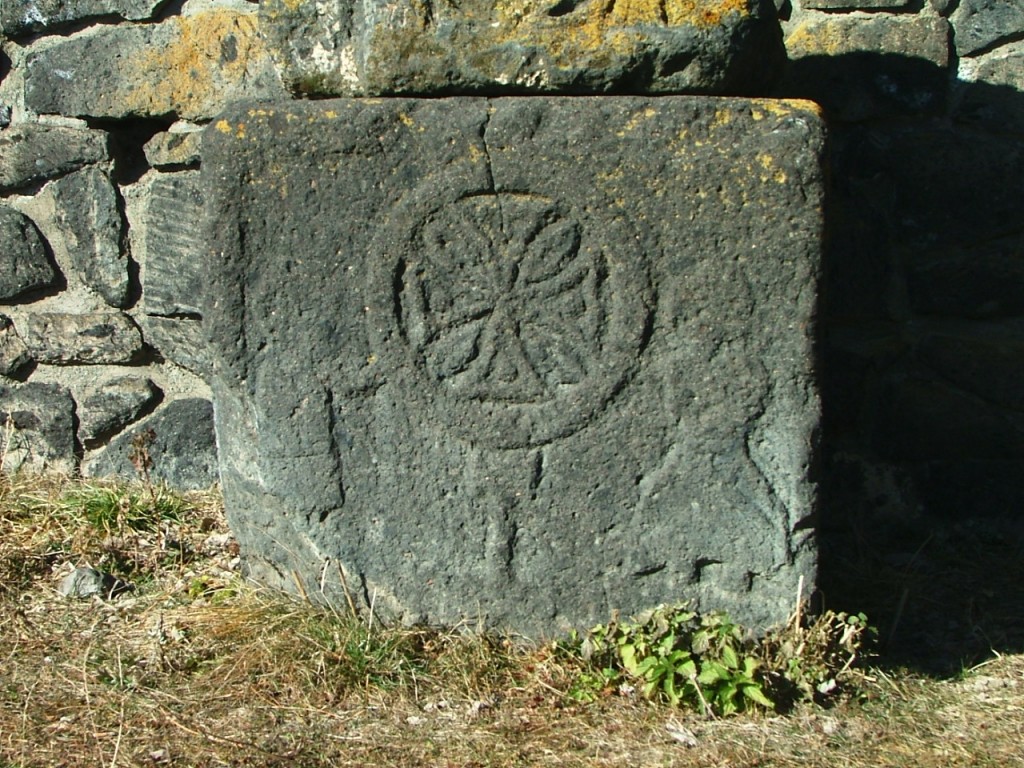 [CLICK TO ENLARGE] Photo taken in November 2010, at the Surp Nshan Basilica, Republic of Armenia. NOTE COMMENT BY Hamid Reza Zohoorian (originally in Persian): The person standing to the right of the emblem is dressed exactly in the style of Sassanian era nobility – a style specifically seen from the time of Khosrow I Anoushiravan (r. 531-579); note that the stance and gaze of the person is again exactly in the style depicted in Sassanian arts. For further analysis see image comparisons following the below paragraphs.
[CLICK TO ENLARGE] Photo taken in November 2010, at the Surp Nshan Basilica, Republic of Armenia. NOTE COMMENT BY Hamid Reza Zohoorian (originally in Persian): The person standing to the right of the emblem is dressed exactly in the style of Sassanian era nobility – a style specifically seen from the time of Khosrow I Anoushiravan (r. 531-579); note that the stance and gaze of the person is again exactly in the style depicted in Sassanian arts. For further analysis see image comparisons following the below paragraphs.
The book is the first of several that would go into the making of The Life of Georgia (Kartlis Tskhovreba) as written in the eleventh-century by the multi-lingual Leonti Mroveli. In a work that is “secular, albeit, fanciful” (idem, p. 60) he follows the pattern, well known to Persian historiography, of mixing semi-historical facts with myth and fables, beginning with the Creation and continuing with “ancestors and kinfolk, the making of Kartli, the history of the pagan kingdom” (ibid) and finally the conversions of Nino and Mirian, and continuing beyond, “until Vakhtang Gorgaslan drove the Persians out and installed a dyophysite catholicos” (ibid) [Footnote 31].
More than adhering to a scriptural model, it seems to have drawn upon the Khwadāynāmag and the Shahnama. Three parts are devoted to the life of Gorgasa(r), including his fighting for the Persians in Sind, allegedly written by Juansher Juansheriani, while the last two parts are about the Bagratid king David the Builder, who may have commissioned the work, hence the emphasis on the Creation and on Pharnavaz. It may have been David’s desire to emulate Persian semi-legendary historiography as a means of establishing his legitimacy as the head of a nationalistic state that could then afford an outreach to other cultures (Rayfield, pp. 59-62; Vivian, p. 7). Later, the chronicles would gradually come to reflect historical facts more than myths, but the basic formula provided by the Khwadāynāmag and the Kartlis Tskhovreba continued to provide the framework up to the last ones written about the Mongol invasions (Rayfi eld, pp. 91-94) That these, too, would not be immune from Persian influence is evident from their use of such terms as Chin-Machin for Greater China (idem, pp. 92f.).
The Kartlis Tskhovreba opened the way for non-religious literature, the development of which had as its starting point a well-known transnational medieval work with roots in Buddhist India, The Tale of Varlaam and Iosaphat, probably the most widely diff used text since the Alexander Romance in both East and West. It so happens that the Greek version was translated from the Georgian which, in turn, may have been transmitted not from Syriac nor from Arabic, but from a sixth-century Middle Persian version, as the discovery of fragments of the story in Manichaean Middle Iranian and Old Turkic from Xinjiang would tend to confirm. In that case the Georgian Balahvariani may well have been the mediator to the West of an Indian legend via Middle Persian (Rayfield, p. 63) [Footnote 32]. These early works set the stage for the further development of secular Georgian literature that harked back to an oral culture imbued with Iranian influence and now destined to be further enriched by contemporary Persian literature, thanks in part to the close relations of King David the Builder with the court of Shirvan which patronized Persian poetry, from Rudaki to the Khorasani school.
Georgians thus became acquainted with the best of Persian literary production early on. Distinguished scholars of Persian such as Gvakharia and Todua are well aware that the inspiration derived from the Persian classics of the ninth to the twelfth centuries produced a ‘cultural synthesis’ which saw, in the earliest stages of written secular literature in Georgia, the resumption of literary contacts with Iran, “much stronger than before” (Gvakharia, 2001, p. 481). Ferdowsi’s Shahnama was a never-ending source of inspiration, not only for high literature, but for folklore as well.
“Almost every page of Georgian literary works and chronicles [. . .] contains names of Iranian heroes borrowed from the Shahnama” (ibid).
Ferdowsi, together with Nezāmi, may have left the most enduring imprint on Georgian literature, but the work of other great Persian poets also came to be known and appreciated, including Khāqāni who calls himself gorji-guy ‘Georgian speaker’ and after visiting Georgia in the suite of the Shirvanshah, wrote about some of the places he visited there. Another poet of Shirvan, Falaki, wrote an elegy to commemorate the death of a Georgian king, while Nezāmi, who lived in neighboring Ganja, could hardly have avoided mentioning Georgia which he called ‘Abkhaz’ (ibid). Very few translations of Persian literary works have survived, but they are major ones in terms of popularity and enduring influence on Georgian literature.
[CLICK TO ENLARGE] PHOTO INSERT & COMMENTARY BY Kaveh Farrokh: Sassanian metalwork at right depicting Khosrow I Anoushiravan and four Sassanian knights (possibly the Sassanian empire’s primary generals). Note the stance of one of the knights from the plate highlighted for reference. Note the figure highlighted on the Surp Neshan Basilica – the parallels of this form (despite the wear of weather over the centuries) with its Sassanian counterparts are virtually exact.
Persian epic and myth, which had found their way into folktales, are reflected in the two major Georgian literary monuments of the twelfth century that paved the way for Rustaveli. The first great epic, Amirandarejaniani, “speaks for a connection with Caucasian folklore” which “had already absorbed elements of the Shah-Nameh, perhaps through a literary translation now lost” (Rayfield, pp. 69f.). It is typical of Georgian syncretism that while Amirani, the chained demigod of the story, is reminiscent of Prometheus, other episodes of the tale would ring familiar to one acquainted with Persian epic poetry, especially that of Ferdowsi and Nezāmi. The text is replete with Persian and Arabic names (including the by then outdated Aspan) as the author, Mose Khoneli, “was saturated in Persian literature,” and his plot evolves in a land without borders where many nations, unhampered by religion, mix and move.
The reader is taken to India, to Balkh and, oddly for Georgia, to the Yemen which had been under Sasanian rule in the last decades of the dynasty and is mentioned in the Shahnama as the home of the treacherous stepmother of Siāvush. The popularity of Amirandarejaniani eventually led to its versification and to the interpolation of new episodes in the seventeenth century (idem, pp. 70-72). The second work, known as Visramiani, is a direct translation of Gorgāni’s Vis o Rāmin, whose origins may be traced to the Parthian period on the basis of the number of Parthian words it contains in Gorgani’s original redaction, though an Indian precedent cannot be excluded off hand [Footnote 33].
Earlier Georgian acquaintance with the original Vis o Ramin is likely, since other pre-Islamic Iranian literary works, such as Ayadegar-e Zareran, are said to have been known in Georgia (Gvakharia 1995, p. 241). It is therefore plausible that Georgians were acquainted with the oral version of the romance at a time when Persian, far from being “a mortal danger to Georgian culture,” as Rayfield suggests, was an enriching factor. It is the only Persian work of that early period which has survived in a complete prose translation, and one so close to the original as to have been used for amending the generally defective late redactions of extant Persian manuscripts, while also helping to determine pronunciation and vocabulary as they were in Gorgāni’s time. The explicitly sexual scenes of the romance were equally shocking to a strictly monotheistic environment where its very popularity prevented it from being printed until the nineteenth century, in both Georgia and Iran. Georgian manuscripts were destroyed for being ungodly, but that did not obliterate the appeal of the romance.
The Georgian translation by an author, who also wrote Th e Story of the Chorasmians, is of such a fine quality that, much like Fitzgerald’s translation of Omar Khayyām, it came to be regarded as a masterpiece in its own right and made such an impression on Rustaveli that he mentions it thrice in terms that indicate that he had read the original by Gorgāni, as has now been confirmed (Rayfield, pp. 72f.; Gabashvili, pp. 35f.). One is left to wonder if the Georgian version could have travelled on to Europe, perhaps in a Greek translation, to influence Tristan and Isolde, as is generally believed. A major masterpiece was in the offi ng and it soon appeared in the form of Rustaveli’s The Knight in the Panther Skin (and perhaps other lost works).
Not much is known about the author whose masterpiece is dated only approximately to the reign of Queen Tamar, some time between the late twelfth and the early thirteenth century (Rayfield, pp. 76f.). It is more Neo-Platonic than religious in ideology, pointing perhaps to interaction with Nezāmi or to Sohravardi, or at least to the same sources of inspiration, including the Greek Neo-Platonists (Vivian, p. 8 ) [Footnotes 34]. It also makes winks to the Zoroastrian Persian past with names such as Parsadan and Pridon, as well as with “oaths in Zoroastrian and pagan formulas, invoking the sun or the four elements” (Rayfield, p., p. 77). Both of his predecessors, the authors of Amirandarejaniani and Visramiani, infl uenced his style or his plot or both, as did Ferdowsi and Nezāmi and probably also Onsori (idem, p. 81). The overall effect was to make a Georgian contribution to a Persian canon” (idem, p. 82).
It is now generally accepted that Rustaveli was well acquainted with the Persian language and was therefore able to read and appreciate its poetry without having to resort to faulty translations. Indeed, this icon of Georgian identity, who left an indelible mark on the evolution of future Georgian literature, is believed to have composed Persian verse (Rhinelander, p. 70). Any attempts to look to the West for the source of inspiration is therefore misguided or driven by preconceptions that do not apply, especially in view of the revelation Rustaveli makes in the prologue: “Th e telling tale I found in the Persian tongue”—a possible reference to Nezāmi’s Leyli o Majnun with which it shares similarities, as confi rmed by Rustaveli’s claim that the Georgian mijnuri ‘lover’ has an Arabic origin (Vivian, pp. 11-14) [Footnote 35].
[Click to Enlarge] A rare collection of Lezgian daggers and swords from south Daghestan (circa 17-19th centuries AD).
Apart from his masterpiece, there are apocryphal attributions to Rustaveli’s pen, including the Tamariani, a panegyric in praise of Queen Tamar. Th e latter is, however, generally recognized as a composition by the somewhat obscure fi gure of Shahrukhadze, who gave his name to a new virtuoso verse-form known as chakhrukhauli (Rayfield, p. 83). Vivian has him travelling thereafter to Iran and to Arab lands, to follow Sufi inclinations (Vivian, p. 10). She also detects traces of Sufism in the work of Rustaveli and fi nds parallels with the Arthurian legends, Wolfram von Eschenbach’s Parsifal, and the Ramayana as well as with troubadours and Minnesängers who were the European equivalents of the mgosani or the later asheqs (idem, pp. 11-15) [Footnote 36].
Rustaveli’s work was destined to be much copied though never equalled. While Georgia had avoided Saljuq hegemony thanks to the Bagrationi, it suffered invasions and occupation by the Mongols and by Timur, as a result of which literary production almost come to a halt, and many of the originals of former Persian-inspired literature were lost, except in references preserved in Rustaveli, Kartlis Tskhovreba and Tamariani (Gvakharia, 1995, p. 242). The only signifi cant work of the fi fteenth century was a medical treatise called Karabadini by a physician named Tsitsishvili who is said to have built it on anonymous Georgian compendia of Galenic medicine of the eleventh and thirteenth centuries CE (Rayfi eld, p. 97). Greek influence is undeniable in medical works postdating Galen, but the title of the Georgian treatise is undoubtedly a deformation of the title of works by Rāzi (Rhazes) and his followers [Footnote 37].
The Karabadini was in turn “superseded by the ultimate compendium of Hellenic and Avicennian medicine” (idem) written by the exiled King David Bagrationi in the sixteenth century. By that time, Georgian literature, still driven by the memory of its heyday, was experiencing a revival that focused primarily on further translations of the Shahnama, especially of the early mythical parts. The culmination of that process was the cumulative Rostomiani, the original version of which began with Zāl and ended with Kay-Khosrō, but was incrementally added to by later authors, such as Parsadan Gorgijanidze, on the basis of off shoots of Ferdowsi’s Shahnama, such as the Bahmannāma (Georg. Bahmaniani) [Footnote 38].
Ferdowsi’s epic would continue to be a prolifi c source of inspiration for translations and pastiches of varying quality thereafter (Rayfield, pp. 96-98; Gvakharia, 2001, p. 483).
This was to last well into the seventeenth and eighteenth centuries, up to the time when Georgia began to look west and north for a new direction. Meanwhile, the combined damage caused by the Mongol cataclysm, the invasion of Timur and the fall of Constantinople in 1453 left Georgia fragmented, with each of three parts ruled by a rival branch of the Bagrationi. That opened the way for the Ottomans and Safavids to determine the course of Georgian history for the next three centuries.
References
E. Akhvlediani and K. Khimshiashvili, “Some parallels between Iranian and Iberian Architectures: Fourth Century BC-Fourth Century AD,” Society, History and Culture in the Persianate World: Abstracts, Yerevan, 2004, pp. 9f.
L. Allen, The Persian Empire: A History, London, 2005.
W.E.D. Allen, A History of the Georgian People, London, 1932.
S. Babaie, K. Babayan, I. Baghdiantz-McCabe, and M. Farhad, Slaves of the Shah, London and New York, 2004.
M. Bāmdād, Sharh-e hāl-e rejāl-e Irān dar qarn-e 12, 13 o 14[om-e] hejri, 6 vols., 3rd ed., Tehran, 1984.
G. Beradze, “Among the Chosen Cities: Tbilisi in the Shiʿi Tradition,” Journal of Persianate Studies 1, 2008, pp. 206-17.
D. Braund, Georgia in Antiquity: A history of Colchis and Transcaucasian Iberia 550 BC-AD 562, Oxford, 1994.
M.F. Brosset, Histoire de la Georgie depuis l’antiquite jusqu’au XIXe siecle, traduite du georgien, 6 vols., St. Petersburg, 1858.
T. Chkeidze, “Georgia v. Linguistic Contacts with Iranian Languages,” EIr. X, 2001, pp. 487f.
Jean Chardin, Voyage de Paris a Ispahan I. De Paris a Tiflis, Paris, 1983.
J. Curtis and M. Kruszynnski, Ancient Caucasian and Related Material in the British Museum, London (British Museum Occasional Paper no. 121), 2002.
ʿAbd-al-Razzāq Donboli, Maʾāther-e Soltāniya, Tehran, 1383/2004.
EIr. = Encyclopaedia Iranica, ed. Ehsan Yarshater, Columbia University, New York, 1983-present; also available online at www.iranica.com.
Eskandar Beg Torkamān, Tārikh-e Alamārā-ye ʿAbbāsi, ed. I. Afshār, Tehran, 1955.
Wilhelm von Freygang and Frederika von Freygang, Letters from the Caucasus and Georgia [. . .], tr. from the French edition, London, 1823.
M. Gabashvili, “Persia and Persian Universe According to Shota Rustaveli’s ‘Knight in the Panther’s Skin’,” in Iran and the Caucasus: Unity and Diversity, Abstracts, Leiden, 2008, pp. 35f.
R. Ghirshman, Parthians and Sasanians, London, 1962.
Idem, “On the History of Persian-Georgian Contacts,” in B.G. Fragner et al., eds., Proceedings of the Second European Conference of Iranian Studies, Rome, 1995.
A. Gvakharia, “Georgia iv. Literary Contacts with Persia,” EIr. X, 2001, pp. 481-86.
M. Gvelesiani, “To the problem of Georgian, Iranian and Armenian Religious Interrelations,” in Society, History and Culture in the Persianate World: Abstracts, Yerevan, 2004, pp. 43-45.
Idem, “The Notion of Iranian xvarənah in Post-Achaemenid Georgian Kingship,” Journal of Persianate Studies 1, 2008, pp. 174-182.
K. Hitchins, “Georgia ii. History of Iranian-Georgian Relations,” EIr. X, 2001, pp. 464-70.
Idem, “Georgia vi. Iranian Studies and Collections in Georgia,” EIr. X, 2001, pp. 490-93.
D. Kacharava and G. Kvirkvelia, Wine, Worship, and Sacrifice: The Golden Graves of Ancient Vani, New York, 2008.
L. Kelly, Diplomacy and Murder in Tehran, London and New York, 2002.
[KIM], “Iranian-Georgian Relations in the 16th-19th Centuries,” Persian Historical Documents, preserved at the K. Kekelidze Institute of Manuscripts of the Georgian Academy of Sciences, www.persian-doc.org.ge, 18 Jan. 2009.I. Koshoridze, “Wars between Russia and Persia and the last efforts of Georgians to revive the Royal Dynasty at the beginning of the Nineteenth Century,” Journal of the International Qajar Studies Association 5, 2005, pp. 41-51.
D.M. Lang, The Last Years of the Georgian Monarchy 1658-1832, New York, 1957.
Idem, A Modern History of Georgia, London, 1962.
Idem, “Iran, Armenia and Georgia” in E. Yarshater, ed., Cambridge History of Iran III/1 Cambridge, 1983, pp. 505-536.
Idem, “Armazi,” EIr. II, 1987, pp. 416f.
John Malcolm, The History of Persia from the Most Early Period to the Present Time, London 1829.
I. Natchkebia, “Unfinshed Project: Napoleon’s Policy in Persia in the Context of the Indian Expedition and Georgia,” Journal of the International Qajar Studies Association 5, 2005, pp. 17-40.
Idem, “Joseph Rousseau on Georgia and the Planned Indian Expedition (1807),” Journal of Persianate Studies 1, 2008, pp. 230-42.
I. Nielsen, ed., The Royal Palace Institution in the First Millennium BC. Regional Development and Cultural Interchange between East and West (Monographs of the Danish Institute at Athens, 4), 2001.
E. Pakravan, Abbas Mirza, Paris 1973.
Robert Ker Porter, Travels in Georgia, Persia, Armenia, and Ancient Babylon II, London, 1822.
T. Pitiurishvili, “Tavvus Khanom, Fath-Ali Shah’s Georgian Wife,” in Iran and the Caucasus: Unity and Diversity, Abstracts, Leiden, 2008, p. 82.
D. Rayfield, The Literature of Georgia: A History, Richmond, 2000.
B. Rezvani, “The Islamization and Ethnogenesis of the Fereydani Georgians,” Nationalities Papers, http://dx.doi.org/10.1080, 18 Jan. 2009.
L.S. Rhinelander, “The Incorporation of the Caucasus into the Russian Empire,” unpublished dissertation, Univ. of Michigan, Ann Arbor, 1994.
H.R. Roemer, “The Safavid Period,” in P. Jackson, ed., Cambridge History of Iran VI, Cambridge, 1986, pp. 189-350.
F. Rosenthal, “Aramaic i. General,” EIr. II, 1987, pp. 250-56.
K. Salia, History of the Georgian Nation, Paris, 1983.
M. Sanadze, “Mirian: the First Christian King of Kartli and the Issue of His Descent,” in Iran and the Caucasus: Unity and Diversity, Abstracts, Leiden, 2008, pp. 91f.
G. Sanikidze, “A Historical Survey of the Georgian-Iranian Relation in the Nineteenth Century,” Journal of Persianate Studies 1, 2008, pp. 148-73.
R.M. Savory, “The Safavid Administrative System,” in P. Jackson, ed., Cambridge History of Iran VI, Cambridge, 1986, pp. 351-72.
C. Scott Littleton and L.A. Malcor, From Scythia to Camelot, New York and London, 2000.
A. Soudavar “Between the Safavids and the Mughals: Art and Artists in Transition” Iran 37, 1999, pp. 49-66.
F. Soudavar Farmanfarmaian, “Haft Qalam Arayesh: Cosmetics in the Iranian World,” Iranian Studies 33, 2000, pp. 286-326.
R.G. Suny, The Making of the Georgian Nation, Bloomington, 1994.
C. Toumanoff, “Bagratids,” EIr. III, 1989, pp. 419-22.
G.E. Tsetskhladze, “Georgia iii. Iranian Elements in Georgian Art and Archeology,” EIr. X, 2001, pp. 470-80.
C. Urjewicz, “La Géorgie à la croisée des chemins: archaïsmes et modernité,” Herodote, revue de geographie et de geopolitique 54-55, 1989.
K. Vivian, Sufic Traces in Georgian Literature, Tunbridge Wells (Institute for Cultural Research Monograph, ser. no. 18), 1982.
Robert Grant Watson, A History of Persia from the Beginning of the 19th Century to the Year 1858 [. . .], London, 1866.
M. Weiskopf, “Commagene,” EIr. VI, 1993, pp. 54-57.
Footnotes
1 Āqā Mehdi Tabrizi was the fi rst recipient of the title Malek-al-Tojjār-e Mamālek-e Mahrusa ‘The King of Merchants in the Protected Lands [of Persia]’ under the Qajars (the decree is kept at the Malek Library in Tehran). Th e date of marriage is not known, but since the Georgian princess was renamed Malaka Khānom, it is to be presumed that they were married soon after he became Malek-al-Tojjār. Unfortunately her original name is not preserved.
2 Braund believes that the young boys and girls sent as tribute were not necessarily Colchians; they may have been sent as slaves, just as Colchians were traded with Greece as slaves and eunuchs (Braund, pp. 49f., 67f.).
3 As worn by the Qajars in the nineteenth century and even nowadays, by Central Asian tribes.
4 In the fi rst chapter of his book, Braund gives an excellent account of how those myths evolved over time.
5 It is noteworthy that the contributions to the catalogue of the exhibition downplay the Persian input to emphasize the local and the Greek (Lordkipanidze, in Kacharava and Kvirkvelia, pp. 24, 26).
6 On glass containers of diff erent shapes being fi rst produced in northwestern Iran in the seventh-sixth centuries BCE, see F. Soudavar Farmanfarmaian, p. 301 fn. 62.
7 The rulers of Pontus were of Iranian extraction, as is clear from their names (esp.Mithridates).
8 For more information on Gumbati as well as another recent excavation at Dedepolis Gora, see Florian Knauss and Iulon Gagoshvili, in Inge Nielsen, ed.
9 Professor David Stronach traces back the origin of the ayvān to the Median temple-palace structure at Nush-i-jān (oral communication).
10 Th e name appears as Meherr in the later Armenian national epic, thus indicating its link with the Iranian Mehr.
11 Salia makes the absurd claim that the cult of Mithras was borrowed by the Achaemenids from Western Asia and spread to Georgian lands (Salia, p. 93).
12 It is to be hoped that Albert de Jong’s fourth volume of the late Mary Boyce’s magnum opus on Zoroastrianism, a large chapter of which will be devoted to Georgia and Armenia, will shed more light on the subtle interplay of Iranian religious beliefs with local ones and their later blending with Greek or Romanized cults.
13 Georgian tradition, which, as in many places, may be derived from the popular Alexander Romance of pseudo-Callisthenes or one of its later redactions, holds that Alexander invaded Iberia and left a Macedonian by the name of Azo to rule (Braund, p. 141). Braund shows how the myth of Alexander inspired the Romans to venture into South Caucasus, not least because Alexander was believed to have reached the ‘Caspian Gates’ (idem, p. 225).
14 Braund does not seem to appreciate the impact of ‘Imperial Aramaic’ on the formation of later variations of the scribal script devised in Achaemenid Iran for addressing provinces in their own language with a single uniform script. It survived well beyond the empire and evolved into local variations for Parthian, Middle Persian, Sogdian, Gandhari and even Sanskrit and Brahmi. In describing Georgia’s ‘Armazic’ script, he makes a confused and erroneous reference to “a lost script from which Parsi and Pahlavi also originated” (Braund, p. 213). Rayfi eld, in referring to the Georgian legendary tradition of a script invented in 200 BCE, seems to have an intimation of the mechanism by which Imperial Aramaic functioned, when he says that the prevalent Aramaic script of pre-Christian Georgia may have been read in Georgian translation (Rayfi eld, p. 20). See also Rosenthal.
15 Braund (chapters 5-9) gives a detailed account of Roman and Byzantine involvement in the Caucasus, from the Mithridatic Wars to the war in Lazica.
16 See Chkeidze for an extensive, though not exhaustive, list of Iranian names.
17 One must therefore insist on ‘Iranian’ rather than Persian, since some names are derived from Parthian, Scythian or Alano-Ossetic.
18 Braund only mentions the Georgian association of the stag with the sun, going back to Pharnavaz. He fails to attribute it to its well-known Scytho-Sarmatian origins as known from many Eurasian burial mounds (kurgans). Th e Georgian name Sagdokht refers not to the dog,but to the stag in the Iranian language of the Scytho-Sarmatians.
19 The unfortunate misperception of Zoroastrianism as fi re worship or fi re-cult continues among Georgians as well as European scholars. It seems to have originated in the martyrologies and hagiographies of early Christian times.
20 Before the recent revision, a Russian-based Georgian scholar confided in private conversation to this author, at the ASPS conference in April 2004, that her peers were reluctant to admit that Mirian was a Sasanian prince.
21 Kartli will be used hereafter instead of the ‘Iberia’ coined fancifully by the Greeks. Eastern Georgia essentially consisted of Kartli and Kakheti, but the core was Kartli where both Mtskheta and Tbilisi were located and which was the seat of the throne of Eastern Georgia.
22 This long-ignored text, in its surviving version, is in Georgian letters. The mutilated transcription of the original Persian was fi nally deciphered by using a Georgian translation. For the corrupted version, see Gvakharia.
23 The correct name in Middle Persian is Gurg(a)sar (Rayfi eld, p. 6). Gorgaslan ‘wolf-lion’ is a later Turkicized form. That this king should be considered ‘semi-legendary’ is probably due to the fact that he is only mentioned in the Georgian chronicles which, like Persian historiography, confuse facts with myth.
24 This is the earliest depiction of a Sasanian royal portrait on a silver dish.
25 Lang fails to mention that in Mazdean eschatology, the molten metal ordeal is meted out only to sinners in hell.
26 Lang also mentions non-codifi ed punishments that were commonly practised, such as burning alive, mutilation, amputation and blinding.
27 Chkeidze gives an extensive list of such names, and points out that Eskandar Beg did not recognize Luarsab as the Georgian equivalent of Ferdowsi’s Lohrasp (Chkeidze, pp. 487f.) In the early Qajar period, however, Donboli (pp. 90f.) clearly recognized Teimuraz as the Georgian version of Tahmurath.
28 The dynasty of Commagene claimed dual descent from the Iranian Orontids as well as the Seleucids. See Weiskopf. For illustrations of the monumental statues of the dual-identity deities of Commagene, see Ghirshman, pp. 57-67.
29 Bevarasp (cf. Av. baevar-, MPers. bēwar ‘ten thousand’, which gave rise to Georgian bevri ‘many’) is the epithet of Avestan Azhi Dahāka (‘master of snakes’ in the Georgian version). See Gvakharia, p. 481.
30 It is interesting to note that Shushanik wore a veil and refused to share meals with men.
31 Rayfi eld, having no acquaintance with Persian historiography, sees in that pattern the more remote model of the Scriptures. Th e Persian model as inspiration is all the more likely that Movreli is said to have been conversant with Persian as well as Armenian and Greek.
32 What Rayfi eld sees as modern Iranian loanwords, namely pasukhi and dasturi, are derived from Middle Persian, as attested by the use of dastur for a Zoroastrian priest. Lang (1956, p. 46 fn 70) clearly says that dastur-i had been used long before, in Old Georgian for ‘trustworthy person’ or ‘minister’, and in new Georgian for ‘agreement, consent’ (from MPers. dastwar ‘judge, priest’). Rayfi eld obviously did not seek advice from an authoritative source, as also demonstrated by his alternating ‘Persian’ and ‘Farsi’ for no obvious reason, and calling Mir Ali Shir Navā’i an ‘Uzbek’, and more gravely, referring to Nezāmi without the suffi x i which he probably assumes to be the Georgian pronunciation in need of correction. Also puzzling is his assertion, allegedly based on elements of narrative and phraseology, that the full Georgian version of Balahvariani, found in Jerusalem, was translated from a non-Christian Arabic text which must have been translated from the Persian versions. He thus contradicts the conclusion to which his own arguments lead (Rayfi eld, pp. 64-66).
33 This was confi rmed by Professor Dick Davis at a talk entitled “Who’s Afraid of Vis or Rāmin and Why” delivered at SOAS in London on November 19, 2008.
34 Vivian mentions a Georgian by the name of Ioane Petritzi who, at the time of David the Builder, studied in Athens and in Constantinople, where he translated Neo-Platonist works that shocked the Georgian Church. His greatest influence in his own country came later, in the eighteenth century.
35 Khāqāni does not seem to have enjoyed the same popularity as Nezāmi, possibly due to the diffi culty of his verse and to the absence of adventure and romance so loved by the Georgians (Gvakharia).
36 Th e Arthurian cycle has been said to have a Sarmatian connection (see Littleton and Malcor) and Eschenbach is also believed to have been infl uenced by Eastern sources. Vivian attributes the tradition of fotowwa to early Islam, without mentioning its earlier antecedents in Partho-Sasanian chivalry and the Ayyārs of Iran. Th e Arabs adopted it and may have passed it on to medieval Europe.
37 Th e Arabized term is derived from the Greek graphidion, but the mere fact that the former, rather than the Greek word, was adopted by Georgians is indicative of the source material used.
38 Interestingly, the earliest Shahnama fragments in ‘New Georgian’ have turned up in mural inscriptions in Vani (Gvakharia 1995, p. 242).
39 The term ‘hostile’ has become such a cliché that some Georgian scholars copy it blindly even when their arguments run counter to its use. See Gabashvili, pp. 36f.
40 For more on this subject, see Rezvani, 593-623.
41 Concerning the career of Siyavush Beg and Jobba-dār, from captive to court painter, see Babaei et al., pp. 118f.
42 Erekle did not trust the Russians, since the family of Vakhtang VI, his rival, were living under the protection of the Tsar in Russia (Lang, 1957, pp. 171, 175).
43 Lang adds that his army was allowed to “ravage the land at will” and the mountaineers of Tusheti, sent, according to their custom, “several hundred noses of slain Lezghis, neatly threaded on string, as a trophy to Erekle.”
44 After an unsuccessful appeal to the French, Vakhtang reluctantly accepted to become a Muslim, while appealing to the Russian ambassador, Volynskii, to invade Iran.
45 These included a General Bagration who fought at the Battle of Borodino, and Prince Vakhusht, who ferociously criticized Rostam Khan, and who later became a Russian senator (Lang, 1957, pp. 118f.)
46 Tsitsianoff was also given to insulting the rulers of Daghestan: “Shameless sultan with the soul of a Persian,” “Yours is the soul of a dog and the understanding of an ass,” “I shall only long to wash my boots in your blood” (apud Lang, 1966, p. 48).
47 It translates as follows: “In Asia, they cannot build such admirable palaces and gardens” (Urjewicz, p. 211).
48 The author wrote fully thirty years after the Treaty of Georgievsk. On the whole she viewed the Turks as ‘savage’, and believed that if “the Persians had had the same communication with Europe, they would have made greater progress in civlization,” because “Turks despise all other nations: Persians respect scholars and esteem Europeans.” But the Persians, though less fanatical and more aff able, had degenerated.
49 “Quant à ‘la vue du visage’, on sait que, le soir des noces, une mariée géorgienne reste couverte de son voile jusqu’ ce que son époux, en lui off rant un cadeau proportionné à sa fortune, l’ait engagé à se montrer à lui” (Brosset II/3, p. 535).
50 See, e.g., Cosroe Chaqueri, The Russo-Caucasian Origins of the Iranian Left, London, 2001.

